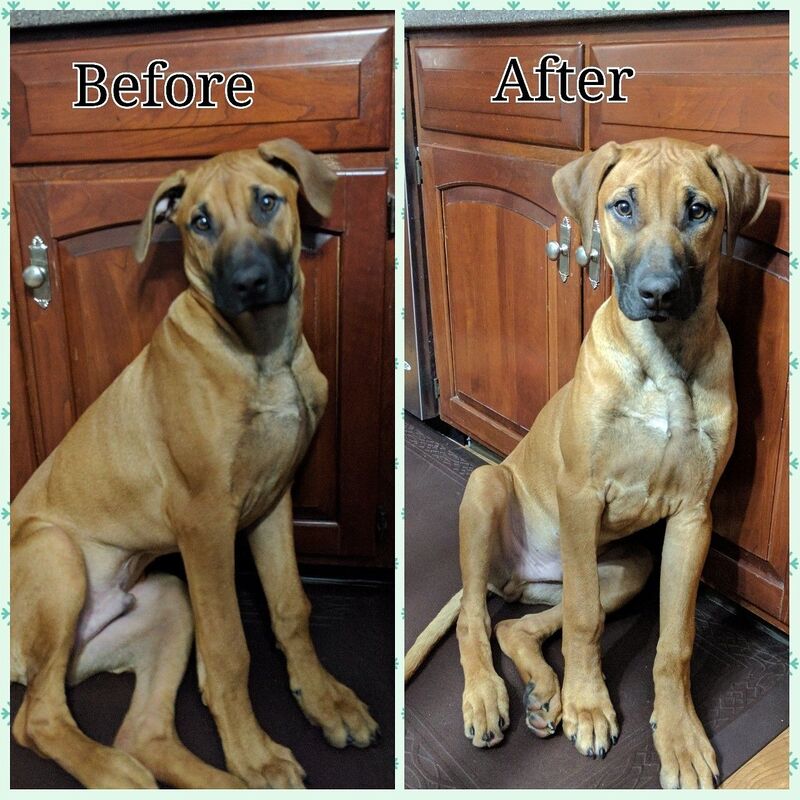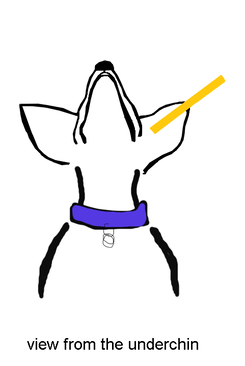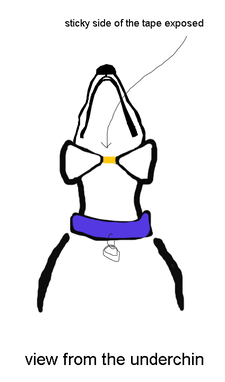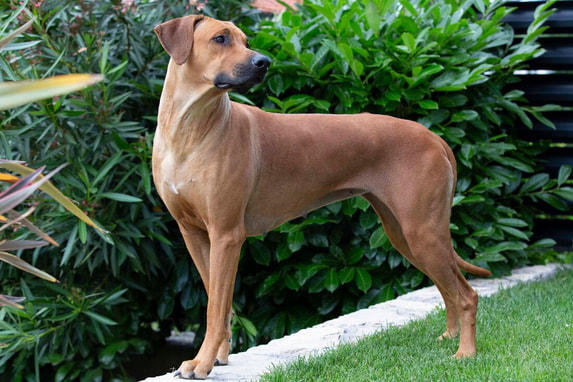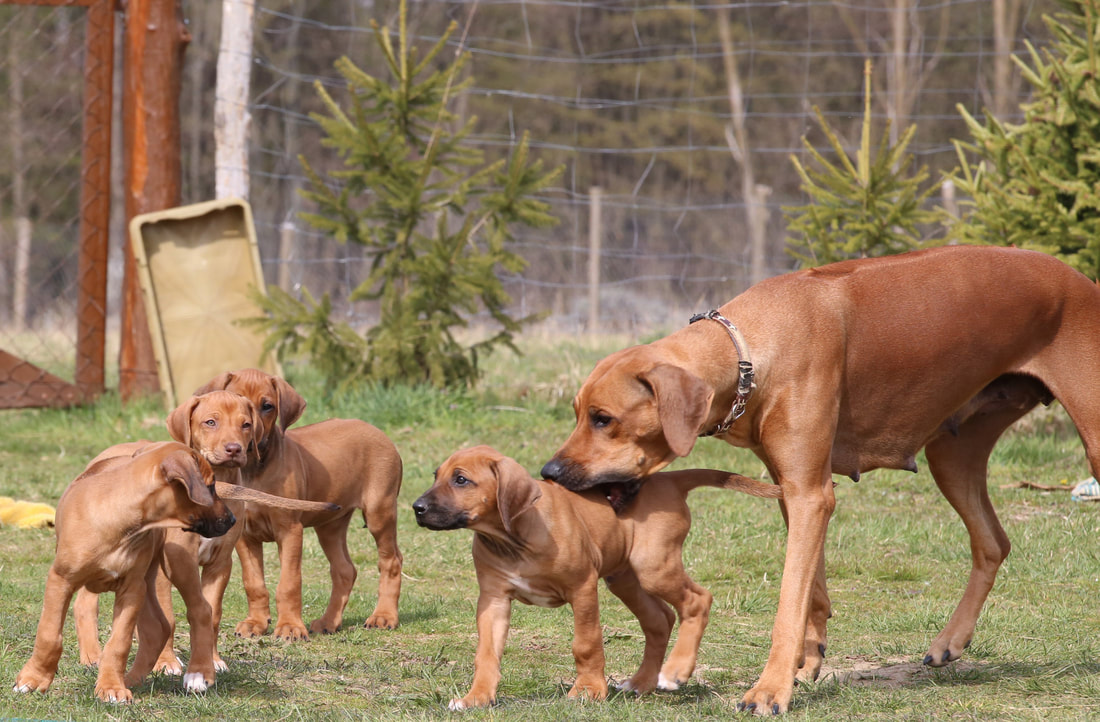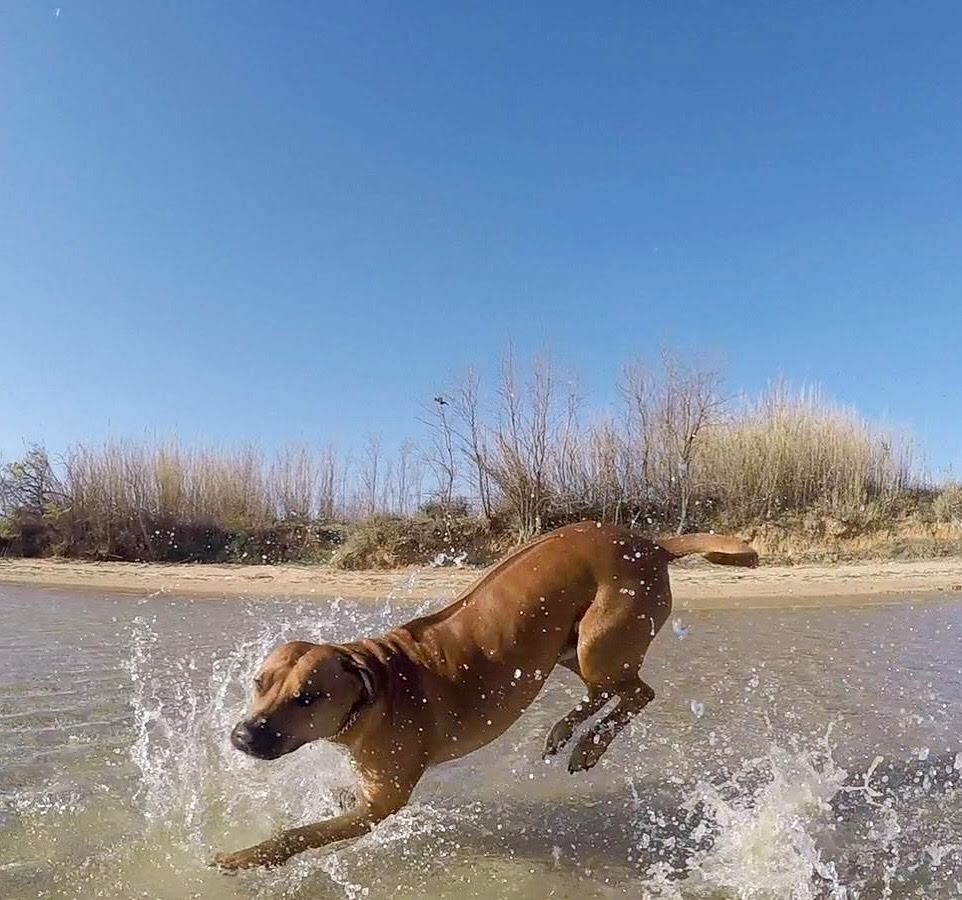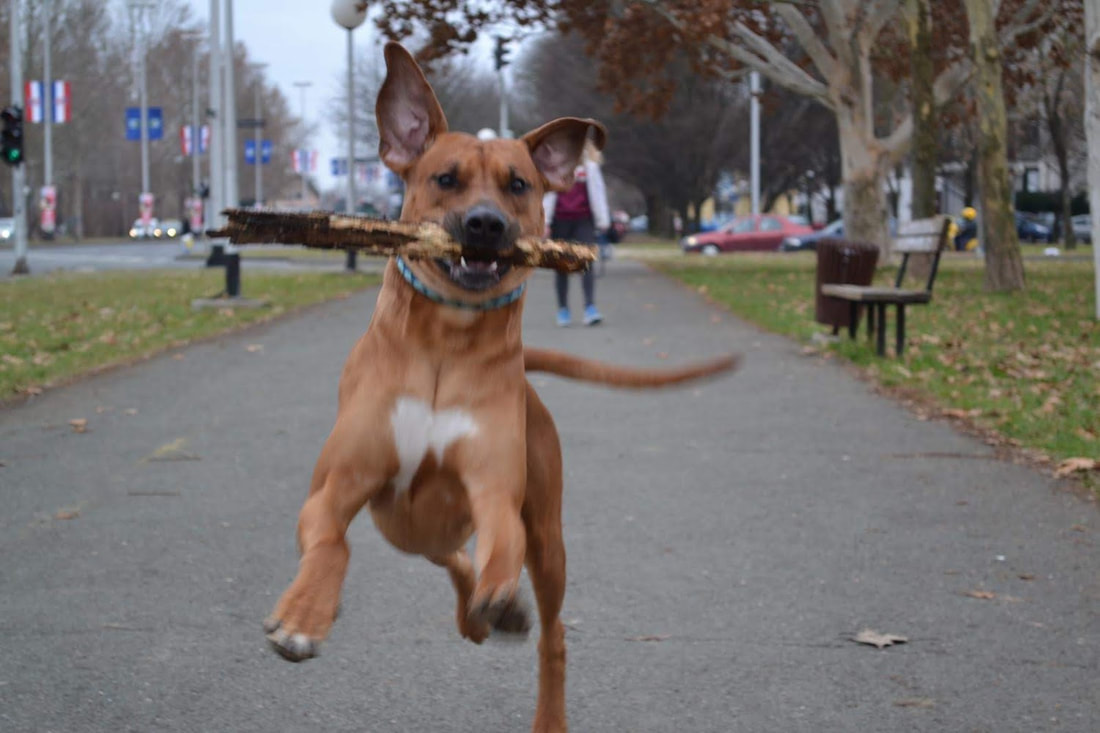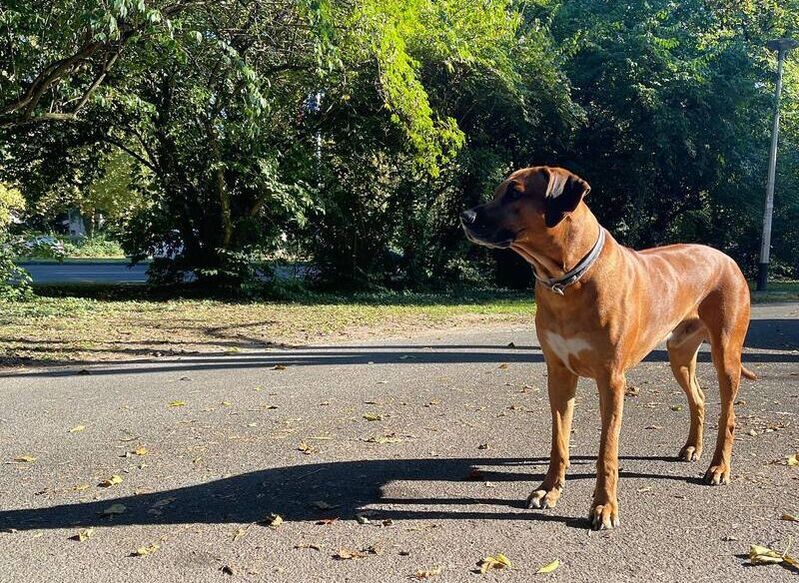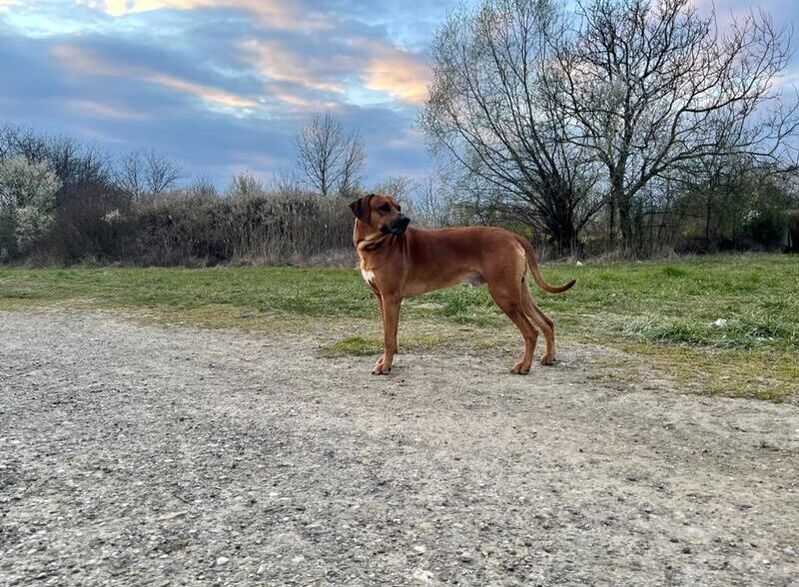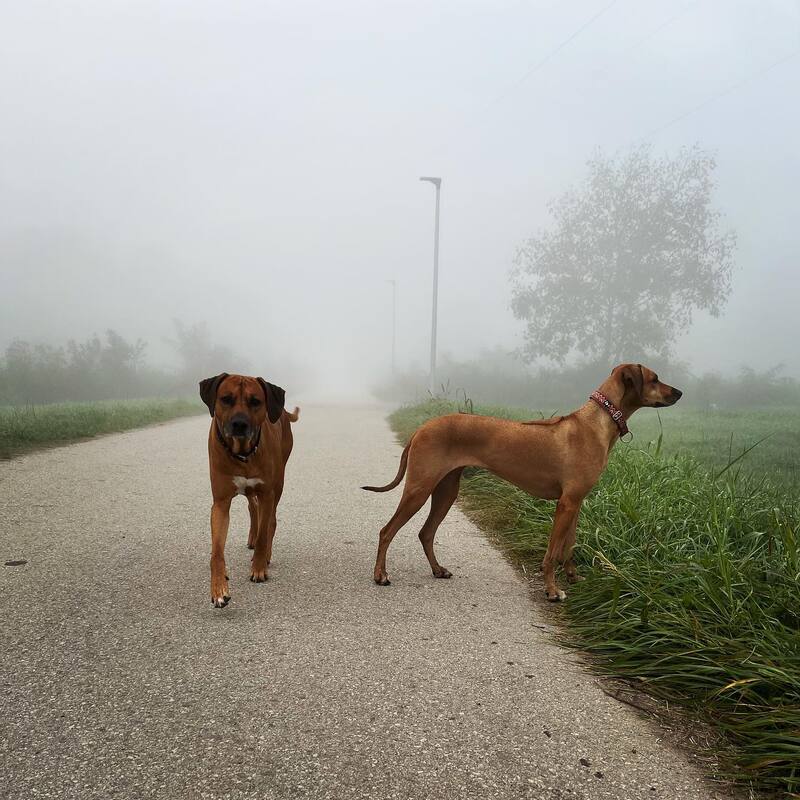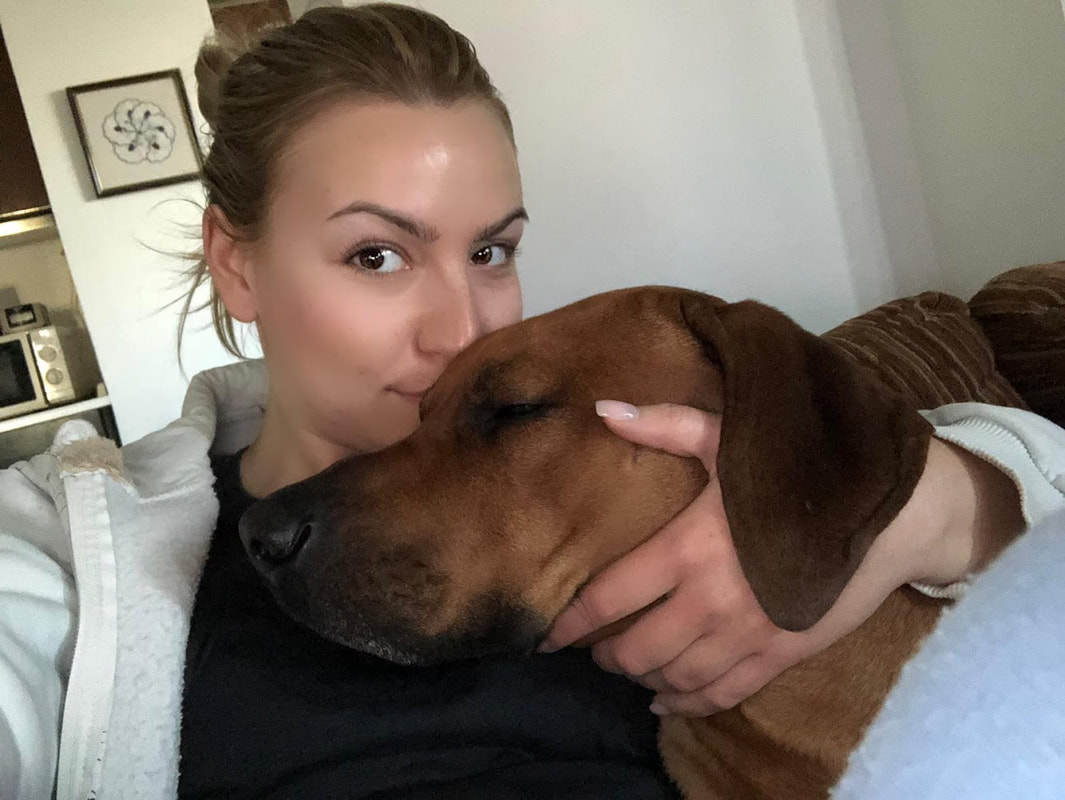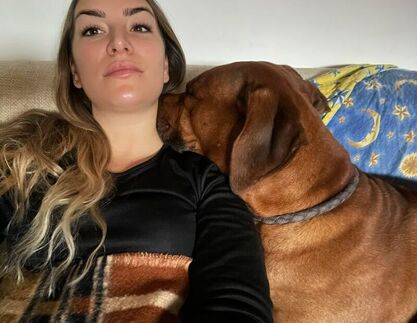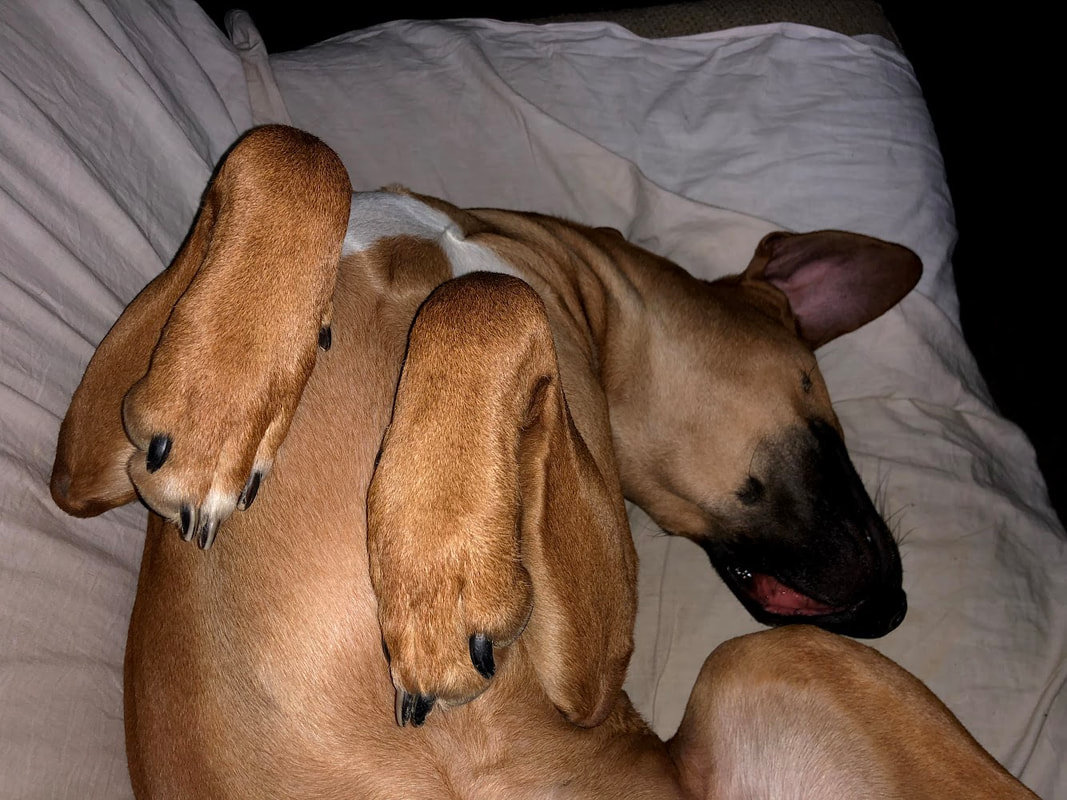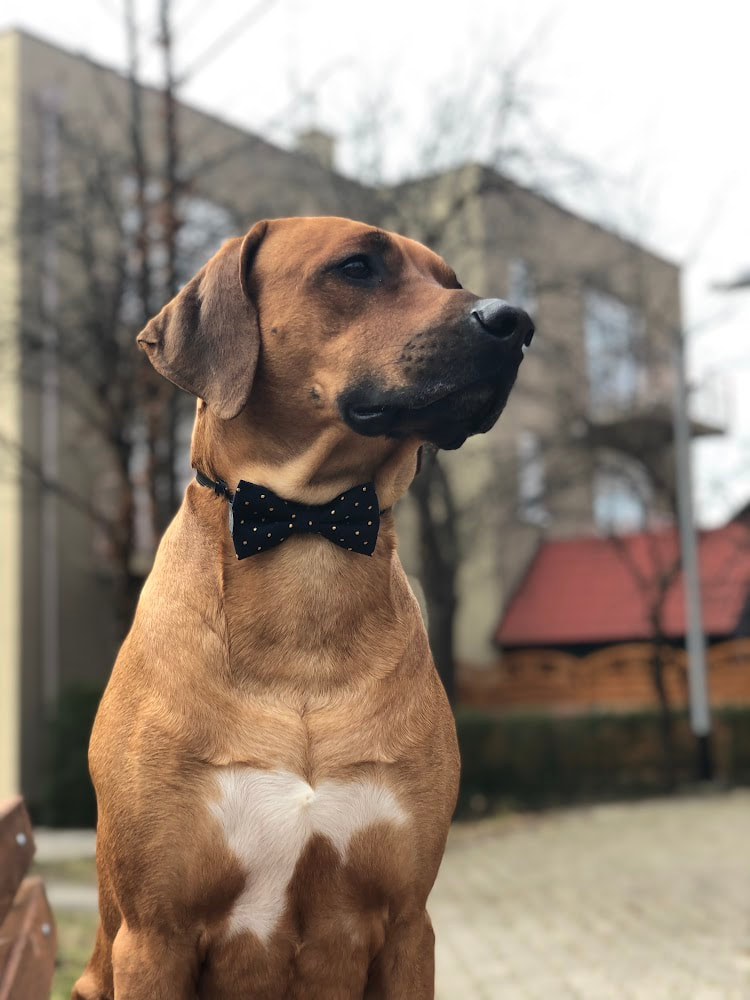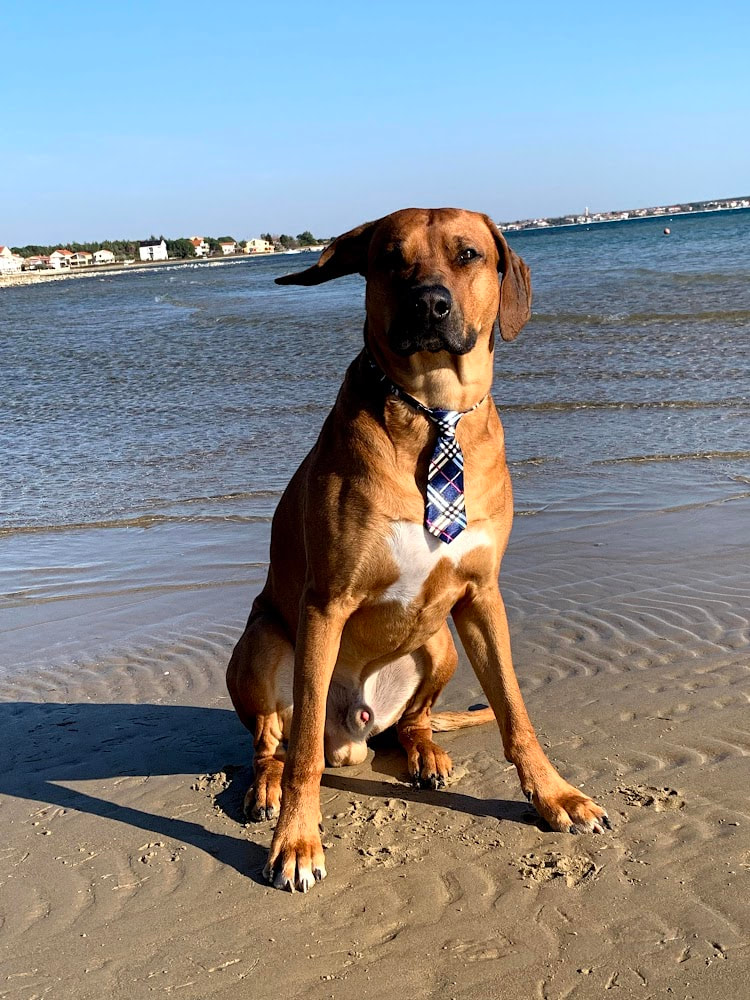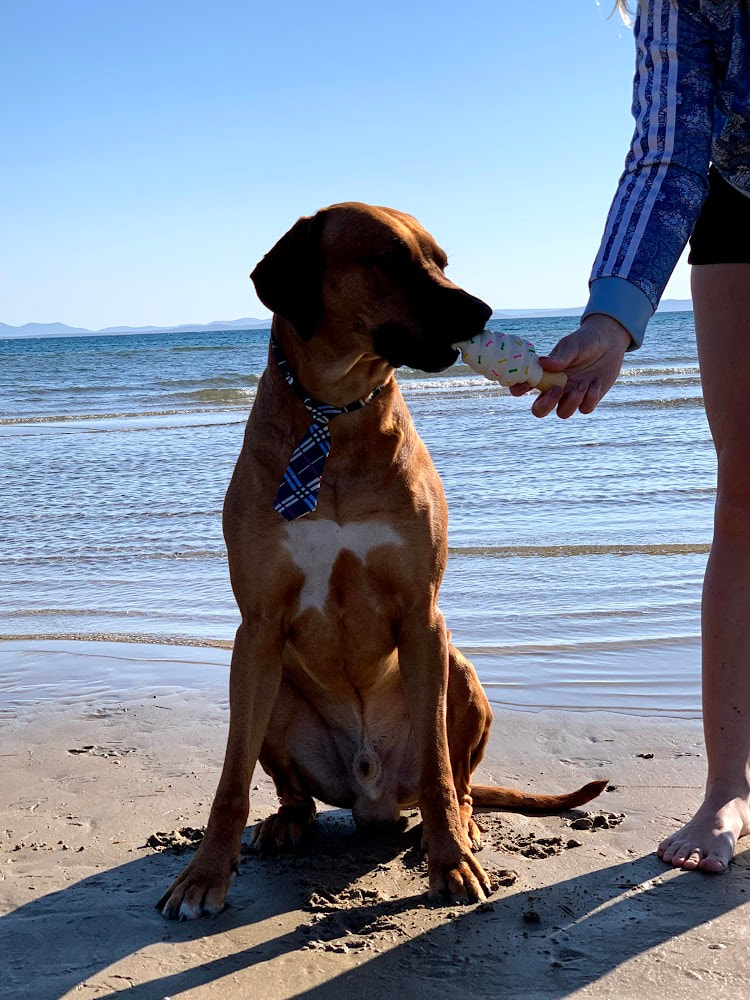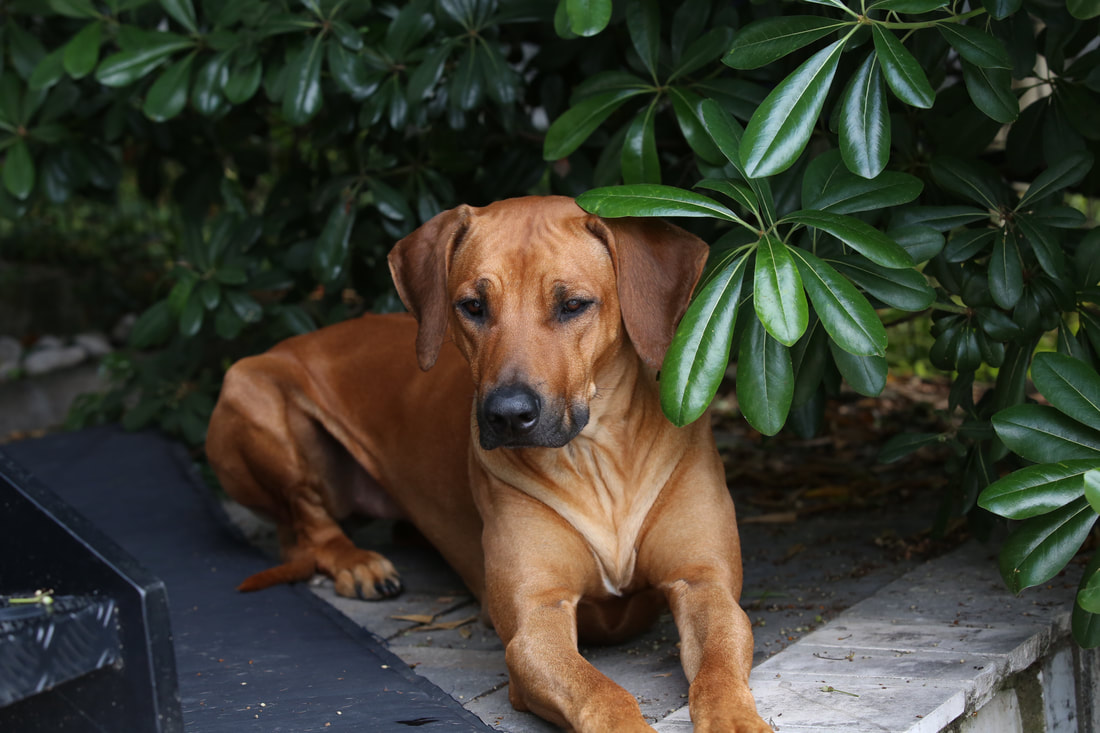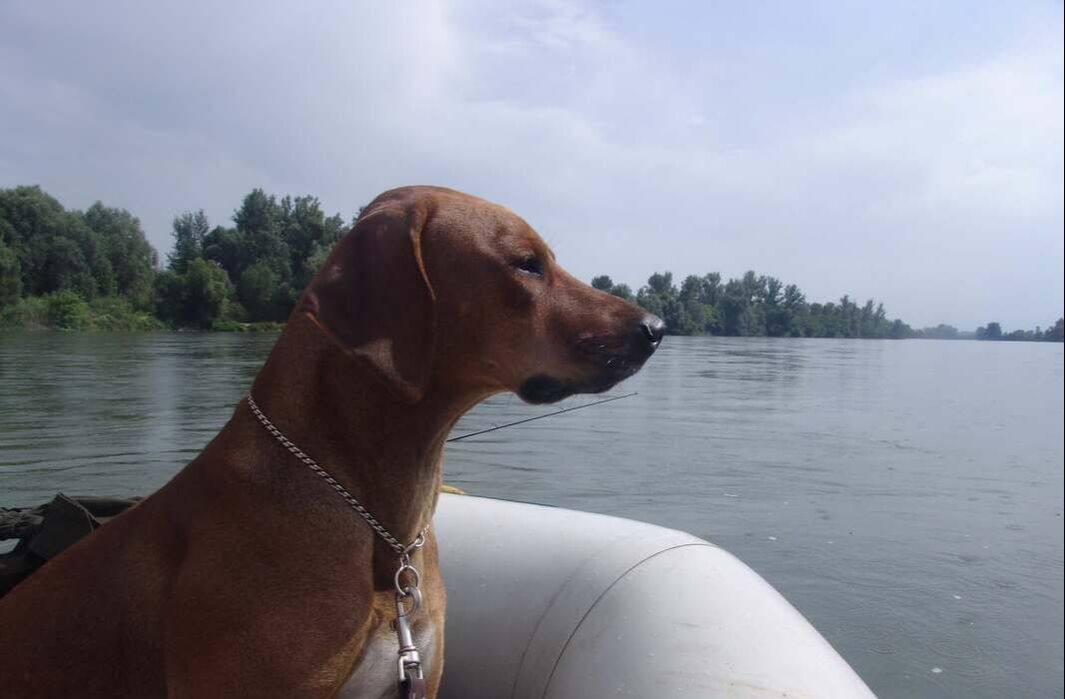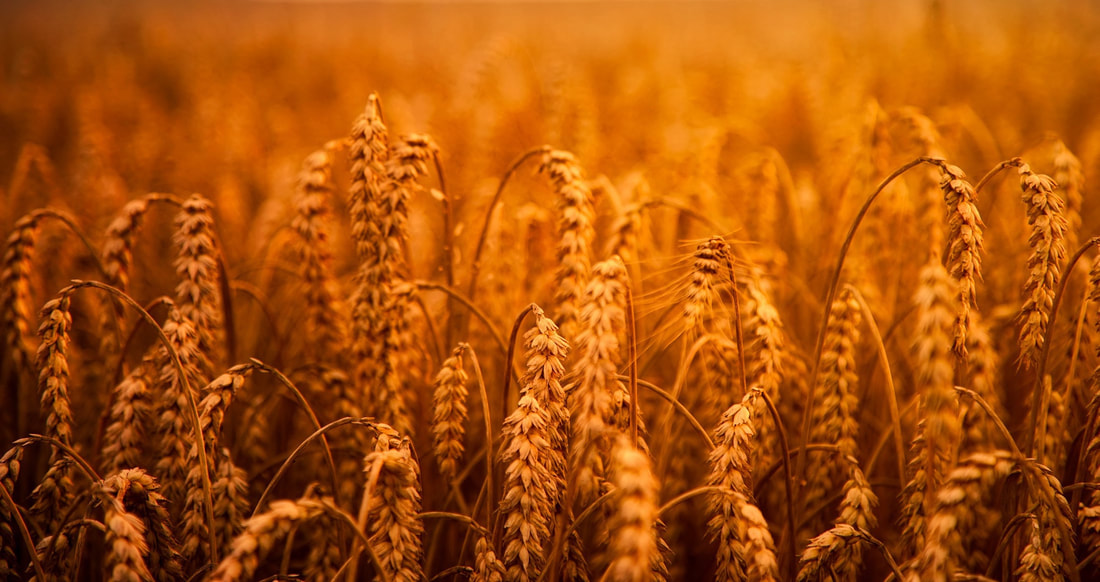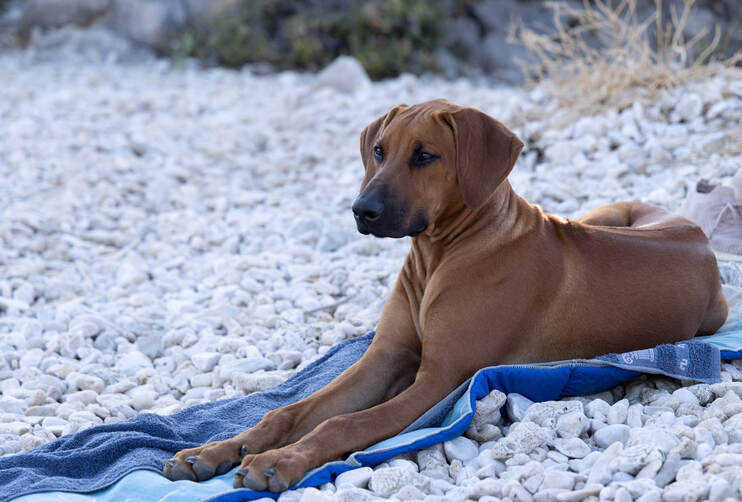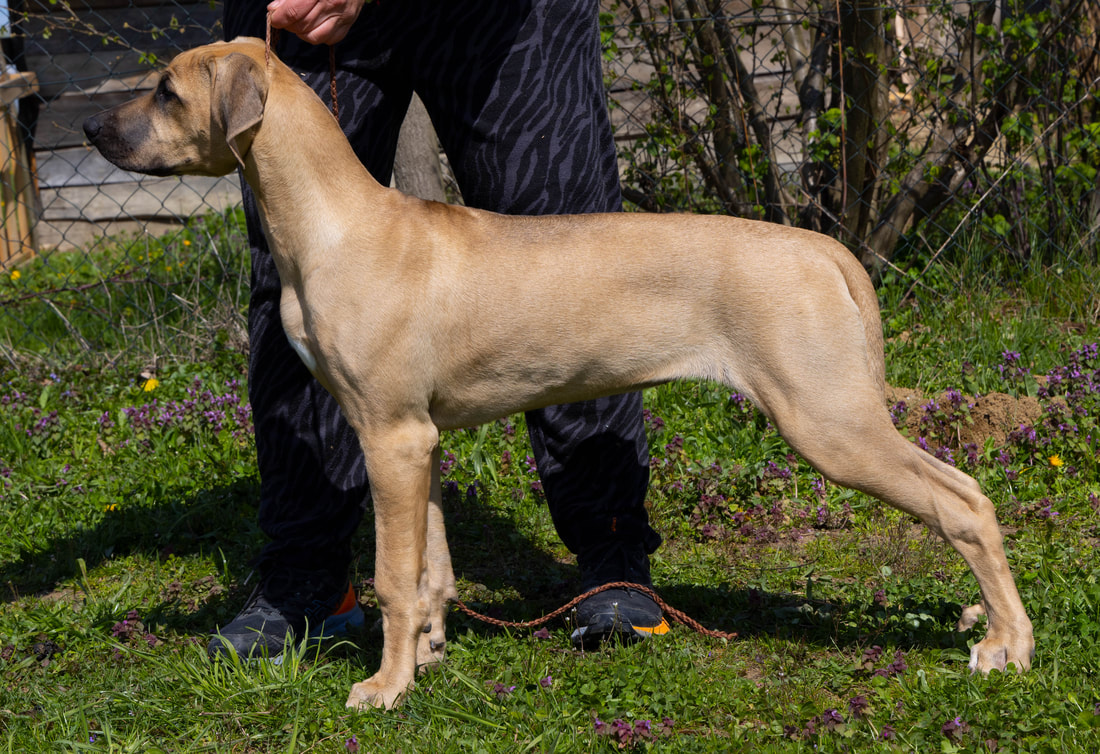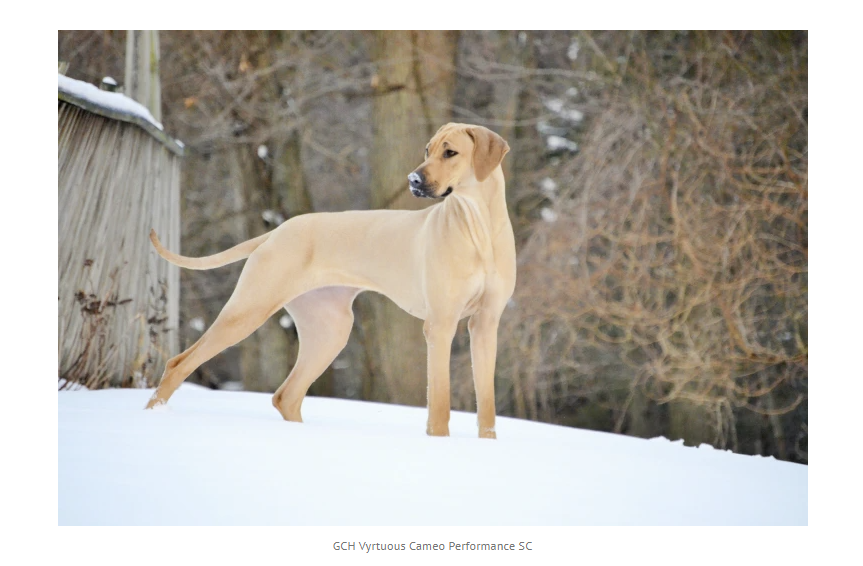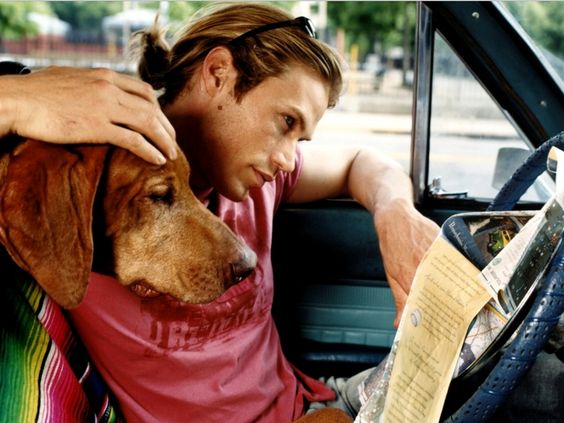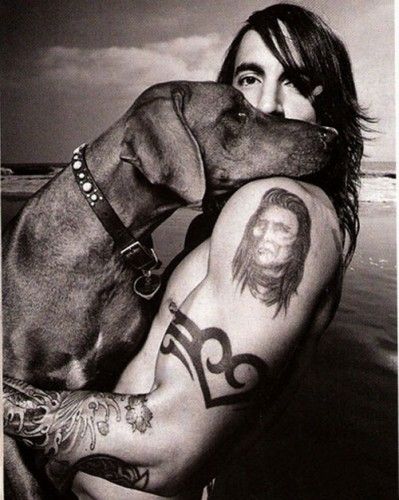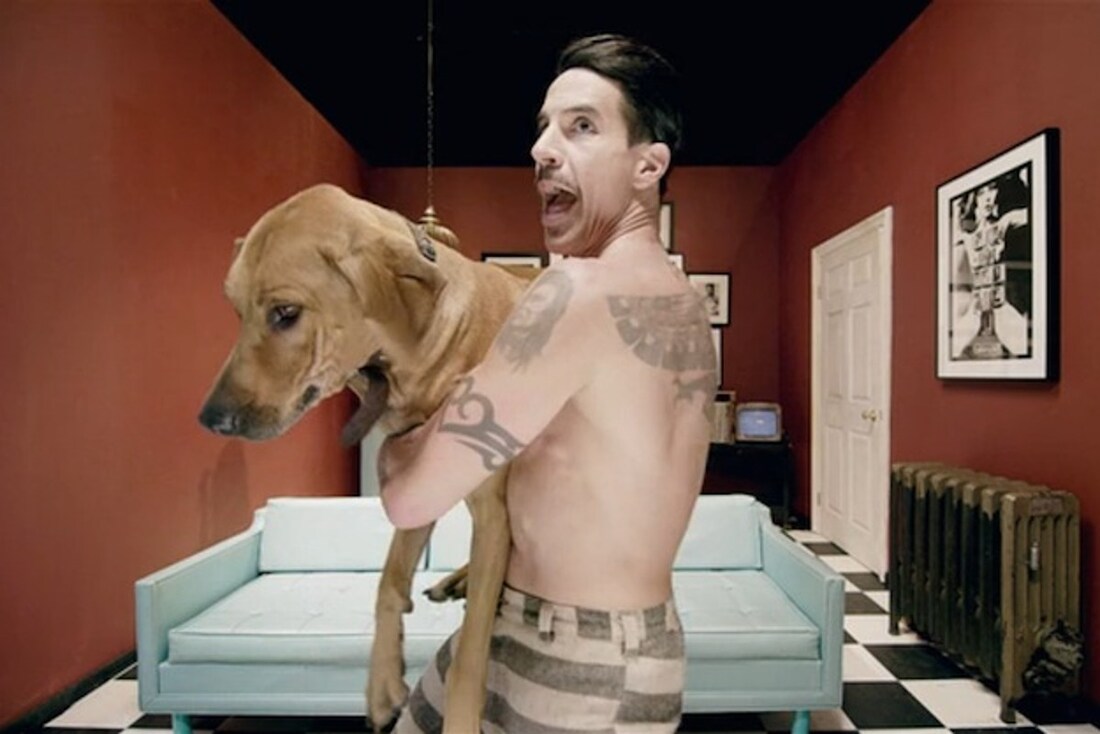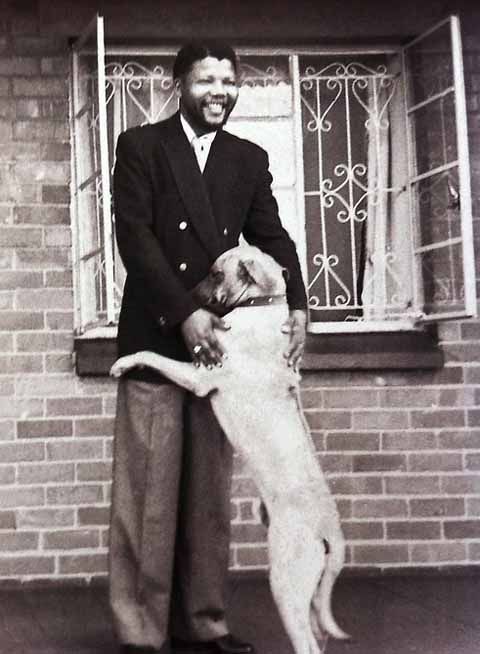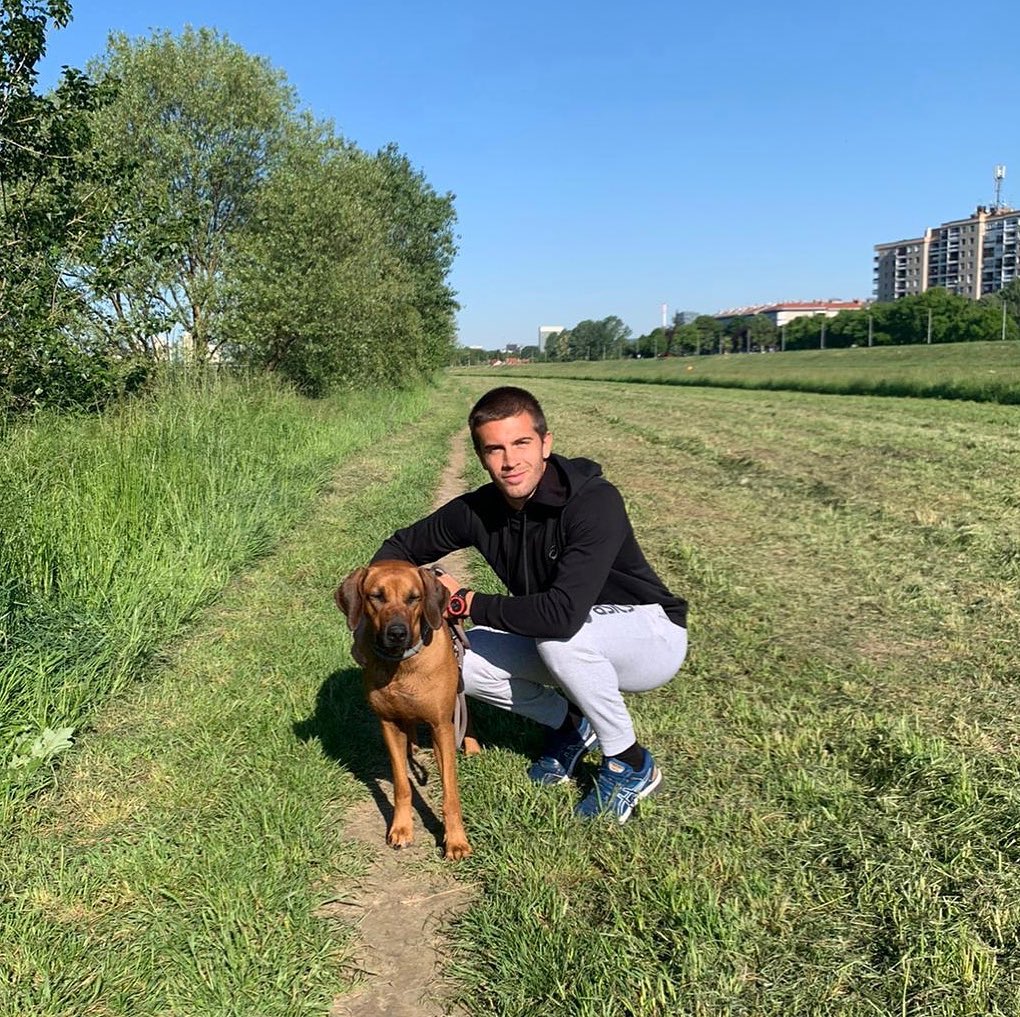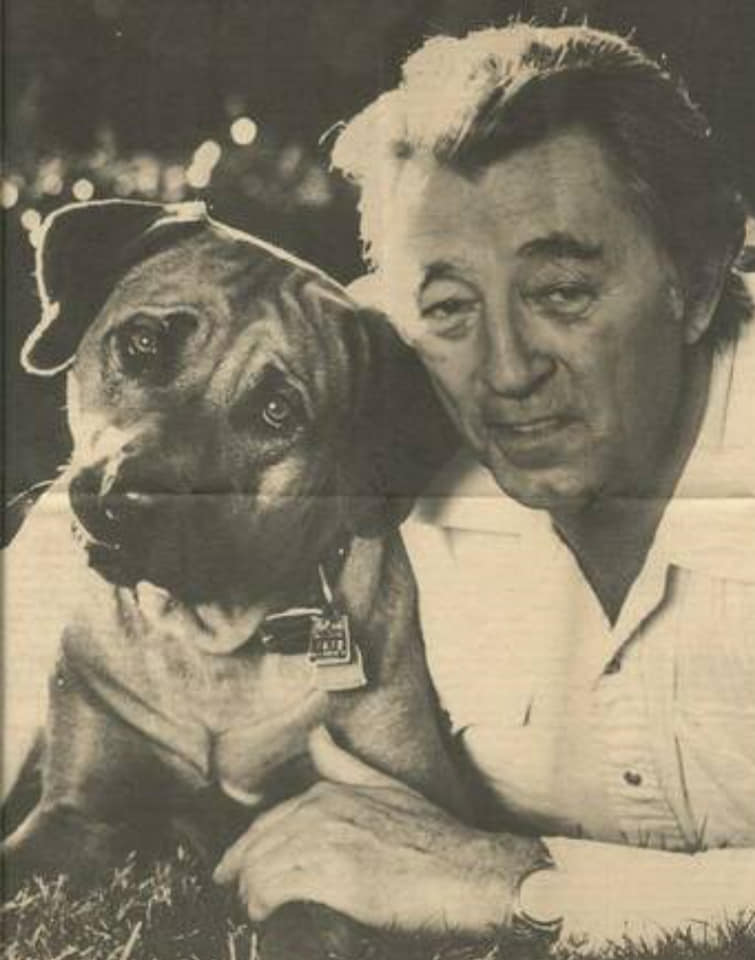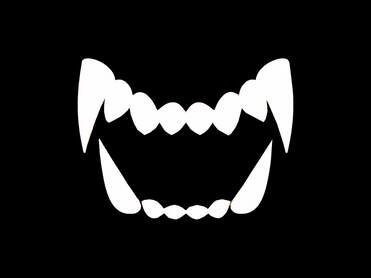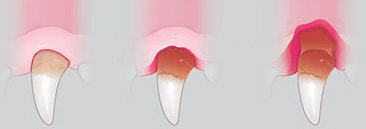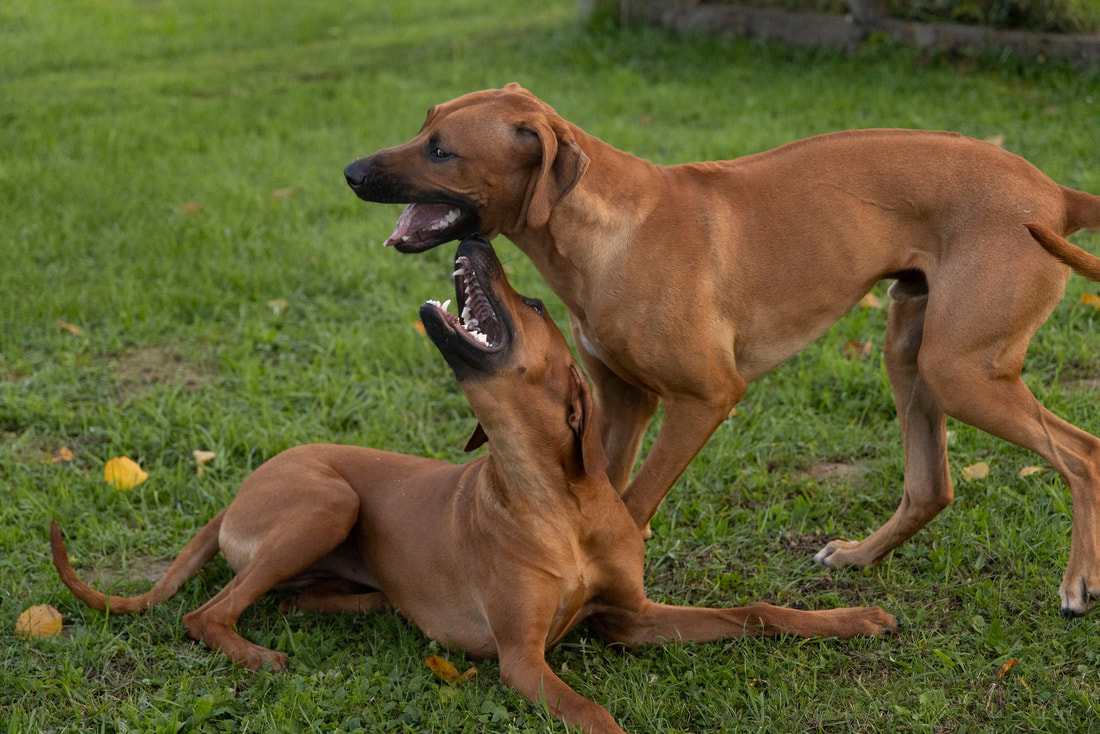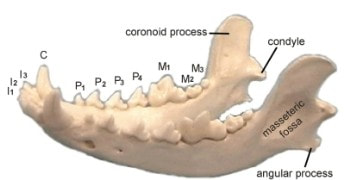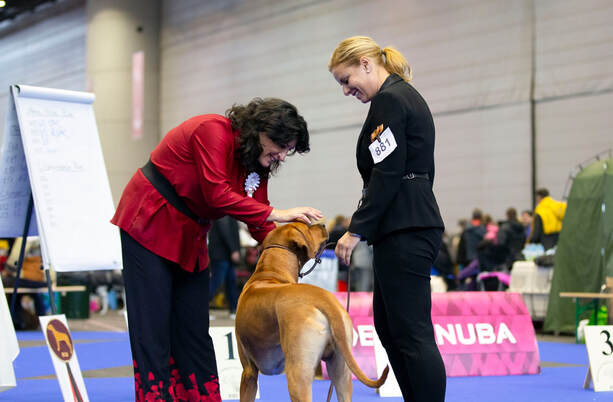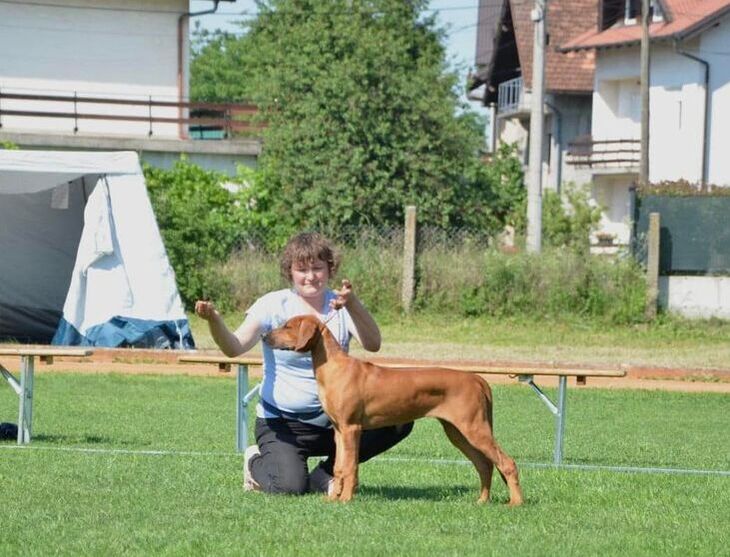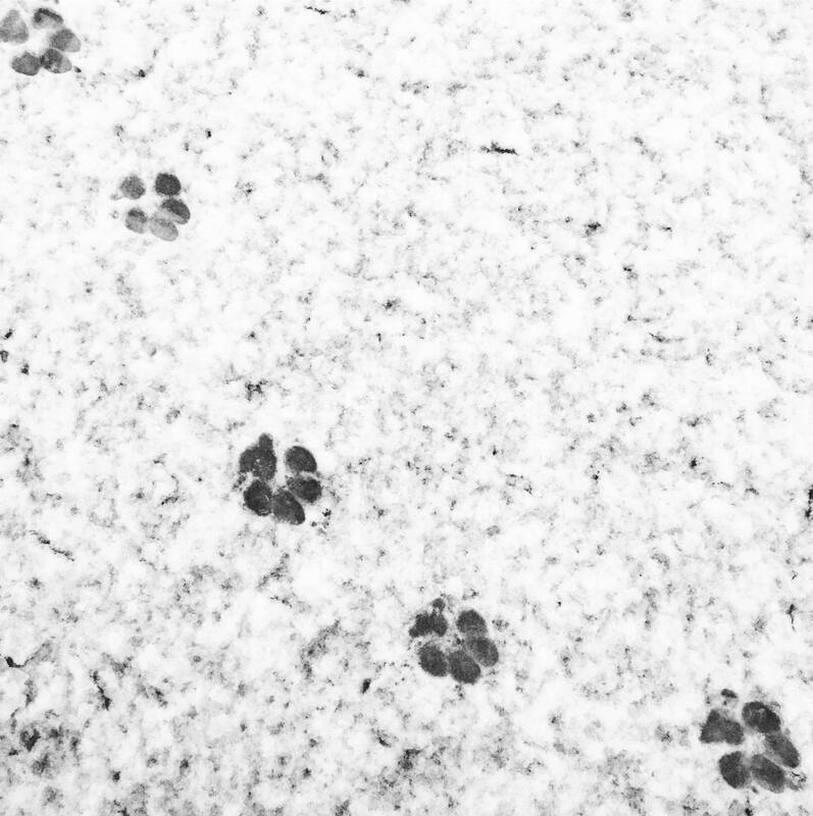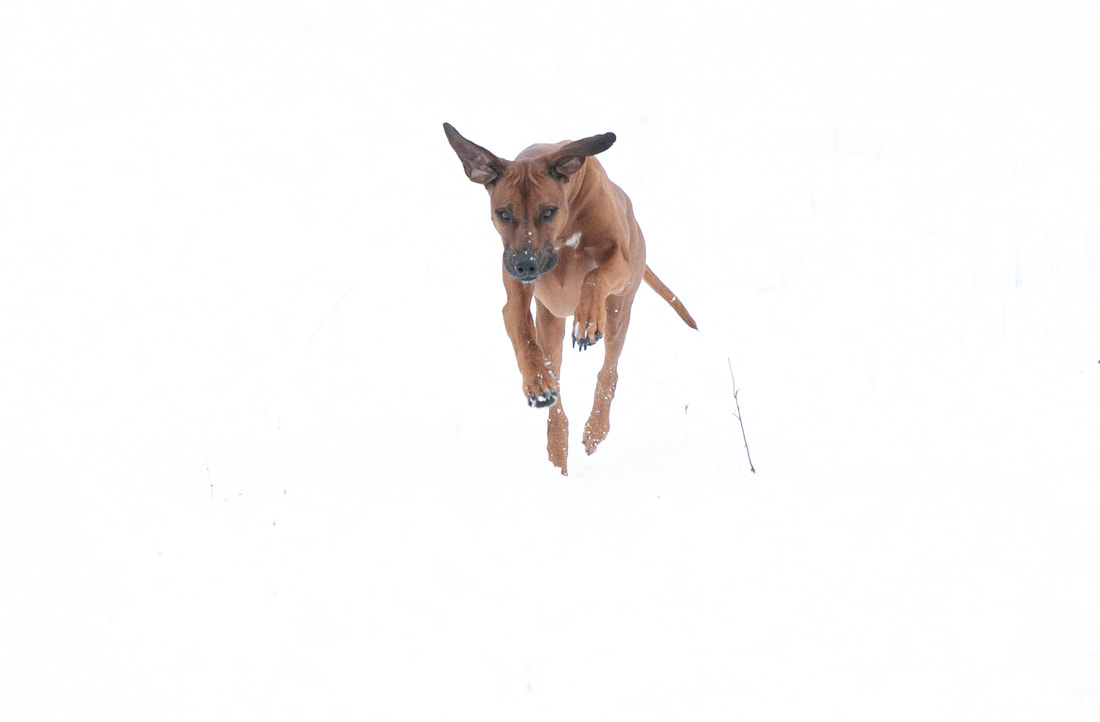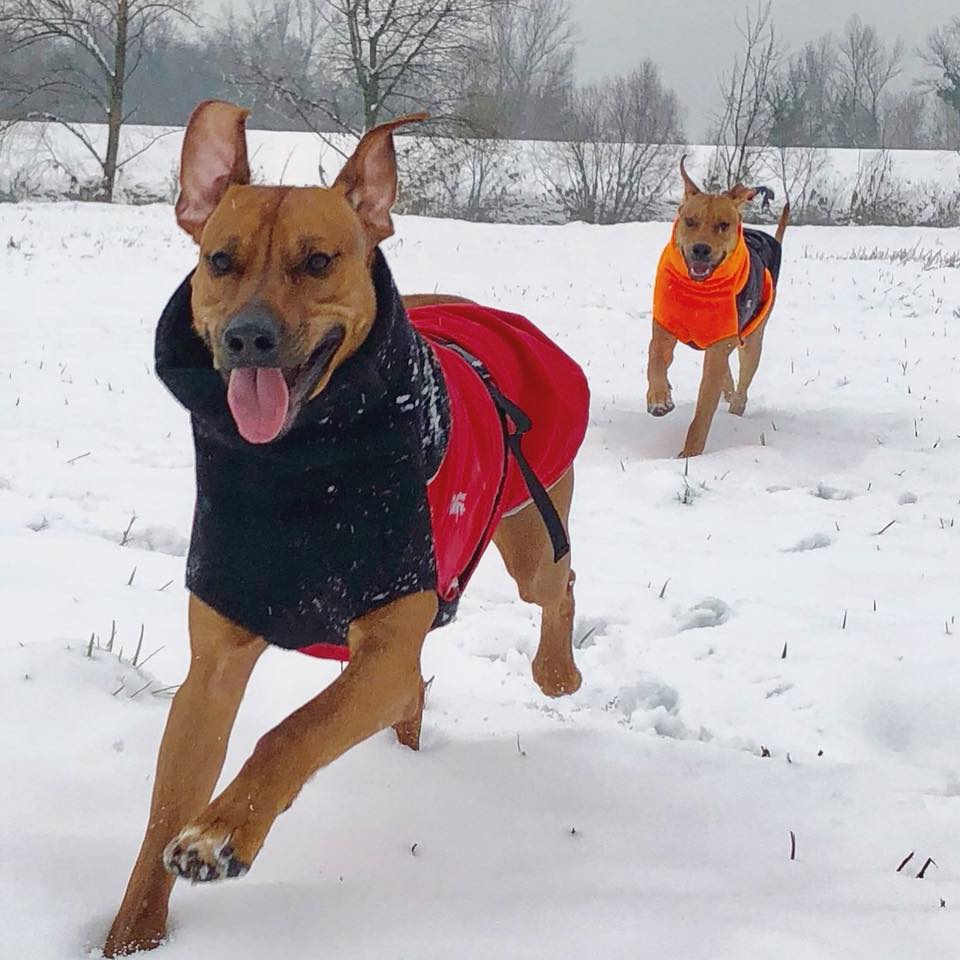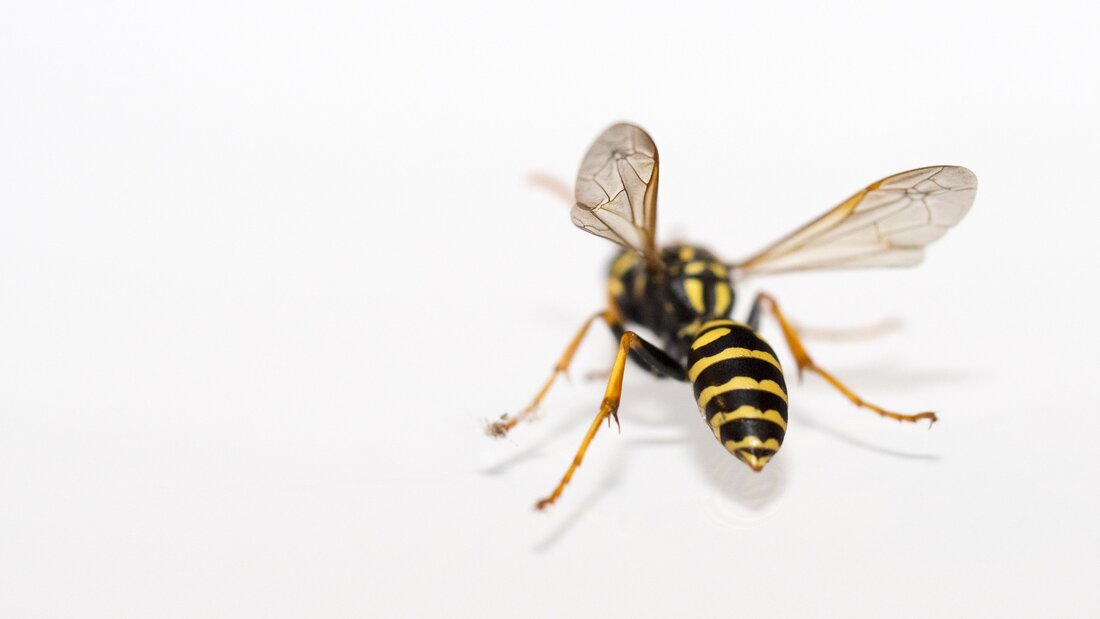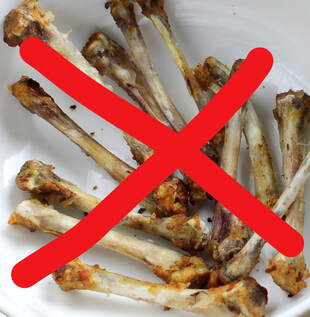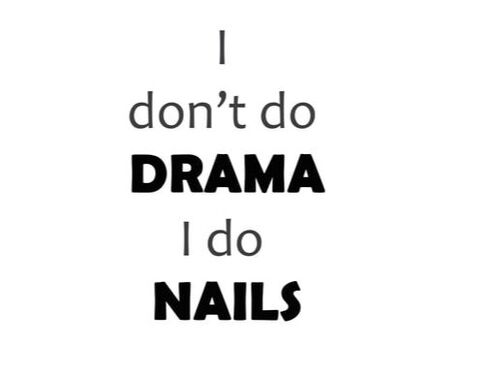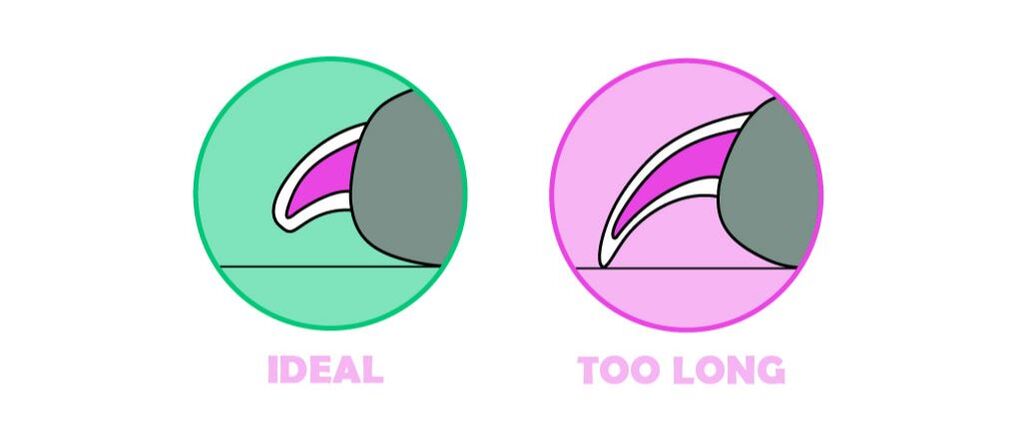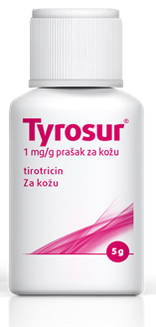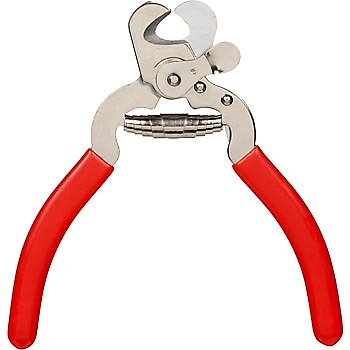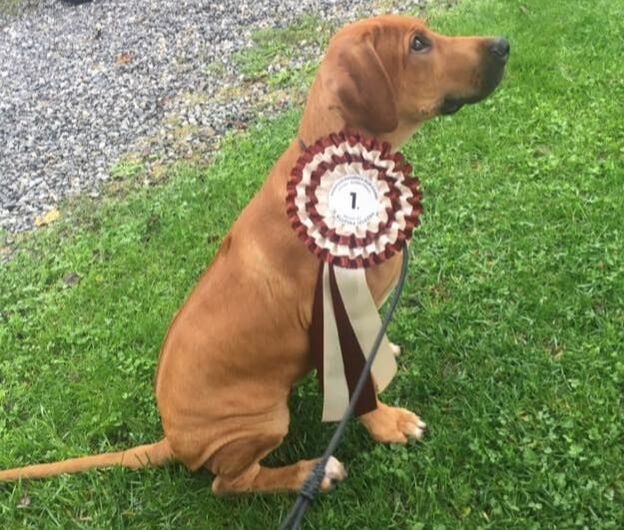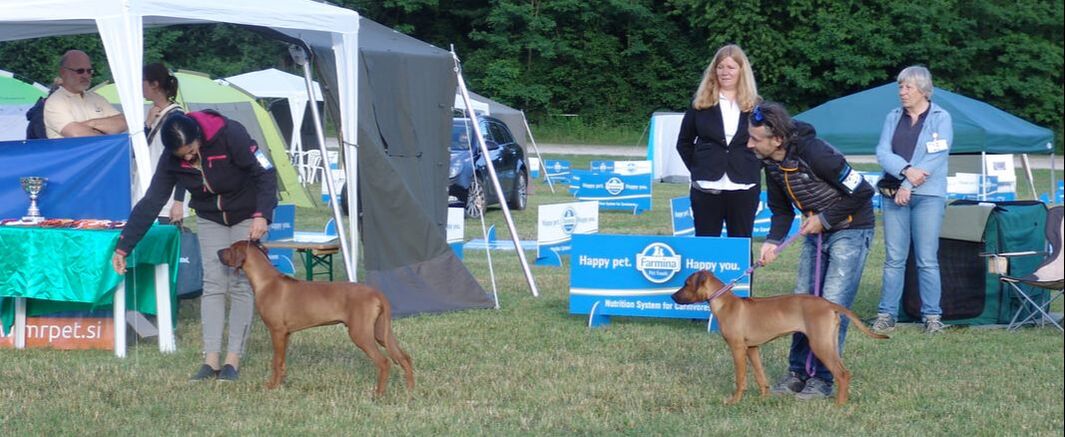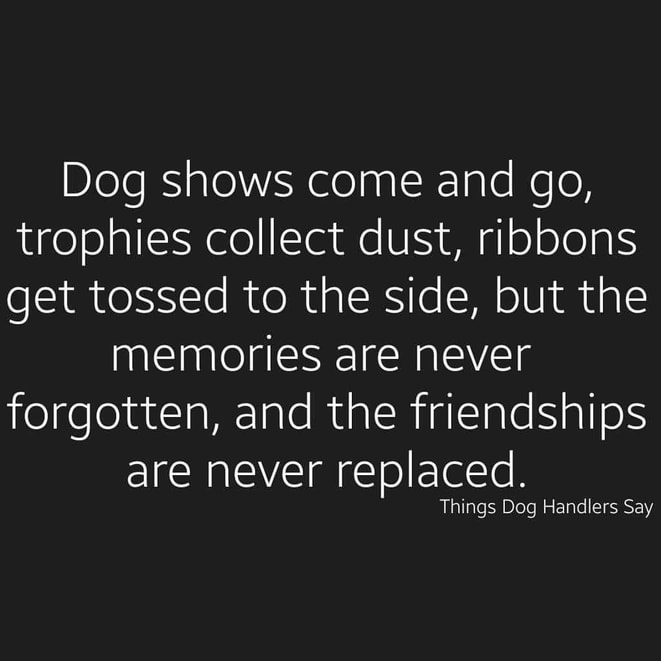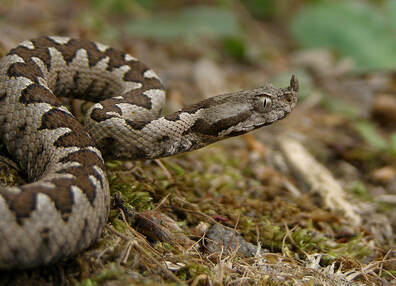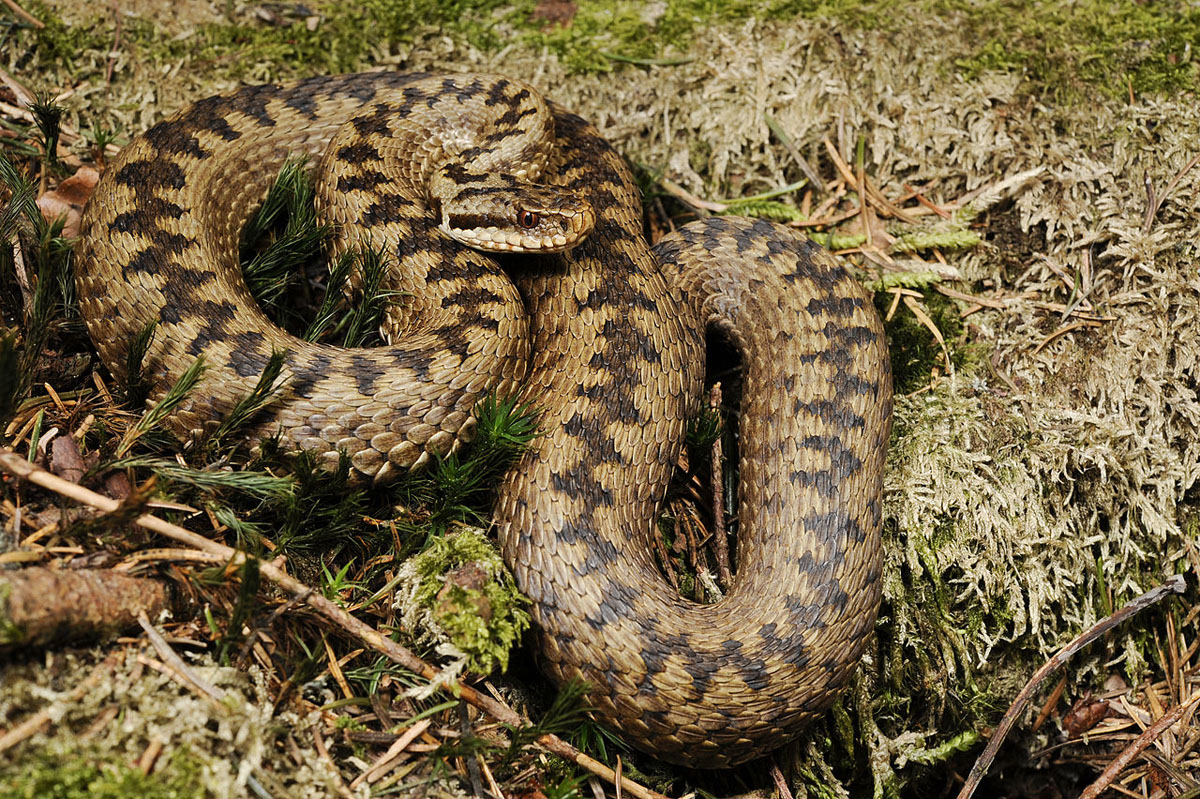|
You probably ask yourself. Ear taping? What do you mean ear taping? This is an adult male which ear has not been taped. It was not a strong "flying nun" ear so the ear sometimes fly away when he is alerted. When he is calm, his ears are on the proper position. This was pretty good outcome. In some other more extreme cases both ears are in the air all the tame. This is why we can use tape in puppy age to fix this. Ridgeback puppies grow like mushrooms after the rain and that growth is intense. During growth, the cartilages on the ears sometimes think that they can grow in their own way and stop listening to the rest of the body and go the wrong way. You will notice this if your puppy's ears are not set/laid symmetrically and if one or both ears start to literally levitate and separate from the skull up and on the side. Puppy with the "nun flying" ear All this happens and can happen in the stages before the teeth change, and if you don't want "Dumbo the elephant", this stage is the most important in order to make a correction. In the phase before the complete change of teeth, ear taping occurs if you want your dog to have nicely carried ears (on proper position). This procedure is most similar to wearing braces for children's teeth :) Once the dentition of your puppy is finished, it will not be possible to correct this and your dog will stay Mr.Sideway-Ear Sometimes the ear sattle down by itself and comes on the good place but sometimes not. When the ear is not flying too much, it is enough to massage the root of the ear gently and to push ears down to skull (from the root to the top of the ear) while petting your pupp. (like you want to gkue the ears on cheeks). Also in this period it would be great if you could add to the puppy food rose hip powder which is rich with vitamin C and helps the cartilages. Ear Taping is nothing horrible or paintful for your puppy, it doesn't take long and the results are more than excellent. Normally you should tape your ears 3-4 days, after this remove the tape for several days to rest the ears and see if they "remember" the place where they should normally be. If ears still fly, repeat this as long as the ears sattle down....Some dogs need more, and some less time but result will be absolutely visible. Mr. Blue after 4 days of Ear Taping photo credit: Jenmy Pelletier For ear taping you will need: Naughty ears :) Alcochol Cotton balls or pads Tape Baby oil STEP BY STEP - EAR TAPING 1 Clean both sides of the puppy ear. Underside and topside should be cleaned with alcochol so you take away dirt and oil of the skin and the fur. This will ensure that the tape sticks well. Be careful with alcochol. Put it on the cotton pads and try that alcochol does not end in puppy ear canal or eyes. 2 Dry the ears! Alcochol will dry up fast but you can use dry cotton pad or paper to dry it up completely. 3 Roughly measure the lenght of the ear by puting the tape stripe beside the ear. The tape should be long as the ear x 2, and then add 1 more lenght which will be bellow the jaw between 2 ears connected. Look at the drawing so you may better understand all lenghts and positioning of the tape on the ears. 4 Apply the tape on the underside of the first ear. Massage it gently and press it so it may stick good to the skin of the ear so you may ensure good contact. Then bring the tape under the jaw (with sticky side of the tape exposed outwards) and apply on the underside of the second ear. Massage the tape again so you get the good contact within tape and the ear. When applying the tape, it should be applied closer to the front edge of the ear (the edge nearest the eye) than directly down the middle. This will allow the ear to fold down the center more naturally. 5 Check the positioning of the ears after taping. The both ear tips should be the last point of contact on the tape and completely simetrical. 6 Now you have sticky part of the tape between the ears facing outwards. You need to cover it with other tape. Measure how long this connection part (between ear tips) of the tape is, and then prepare a new tape that is few centimeters longer. With this you will ensure excess runnig up the fur side (outer side) of both ears. It is not necessary that you run this to the top/root part of the outer ear and that this tape follows the lenght of the tape which is positioned under the ears. It can be shorter. You should again massage the tape to ensure good contact. 7 After 3-4 days you should remove the tape so the ears can relax. It will be super if the ears remembered the proper position, but if not, repeat this procedure in 3-5 days and do so as long as this naughty ears understand where their proper place is. Ater taking off the tape there will be some waxy leftovers on the ear. Use the baby oil and take it off with oiled cotton pad. Oil is melting all waxy things. There will be some reddering on the places where the tape was applied, it is nothing to be concerned because this will go away. VIDEO TUTORIAL
0 Comments
We will assume that you before you start to communicate with the breeder have studied the breed well, done exhaustive research, met some Ridgebacks and their owners and asked them everything what interest you and that you know approximately what awaits you in your future life with your Ridgeback. Once you have prepared yourself and are ready for the challenges of this wonderful breed, you can start thinking about whether you want a female or a male. We are experienced breeders and we will suggest you is it for you better choice a male or female for you depending on a puppy temperament as well. Ridgebacks are powerful strong athlete dogs. When we speak of the differences that may really exist between male and female Ridgebacks, it must be understood that these are all generalities, excatly like with human. While a male or female may be more likely to possess a certain characteristic or behavioral trait, this does not mean these generalities apply on every dog. This is why its so important to evaluate puppies dispositons accurately and carefully. We evaluate every puppy and make a record of individual personalities through observation and later with Volhard's aptitude test to confirm what we already know. Based on that we make a decision what puppy will best fit a particular lifestyle. The personality differences that may between individual dogs have a much wider margin than that which might exist between the sexes. Already in puppy age the power is present. Rhodesian Ridgeback puppies are like small machines ARE THEY FROM A SAME PLANET, OR LIKE HUMAN FROM VENUS AND MARS? Males can be more dominant, territorial, and easily distracted than female dogs. They are bigger and stronger and more muscular than females. But, also tend to be more demanding of attention, affectionate and focused on human beings than female dogs. Females are generally are more independent and inconsistent in their focus on their human companions, but not in every case. Females can be every bit as loving but after gaining their owners affections awhile, they may prefer to go off on their own. They have thein own business to do. This doesn’t mean that females aren’t affectionate, but they seem to be more “choosey” with their moments of cuddles and kisses and might be more reserved, similar how the cats act. Just imagine how it is in the nature. Females are the ones that go to hunt and bring the food, and males are just resting, going around and protect the pack when they have to. This tells a lot about male and female attitudes. Males are "simple", comparing to females which are bit complicated especially when they are in the heat. This occurs twice a year for two to three weeks when the dominance and territorial behaviour can also be seen in females. Because of the heat you will have periods when you will have to be careful when walking your bitch. It is better to walk her in areas where there are not many dogs. Males are going to smell the bitch and they will try to hop on your girl, especially when the heat is in its zenith. Any unneutered male dog will be boisterous and persistent, at best, and accidental mating is always a possibility. Nothing can stop hungry or the horny one. These are two main instincts of animals. It is all about to eat and mate. And yes..."the heat" periods are much more hard for male owners. If you have a bitch, you just go away from other dogs and are a bit more careful, but male owners will have males that sing, do not eat and are pretty crazy if they smell the lady with perfume somewhere around. If your male dog is not neutered, you need to make sure he has an area to exercise in that he can’t escape from – especially if there are female dogs on heat nearby. Bitches also have often false pregnancies after heats and this is why we wrote that you will have hormon storms from time to time. Males leave more urin marks around, when they walk than females, but in the heat, bitch is marking with urine much more. She is leaving the invitation cards everywhere so the pretty guys may find her easier. It is her instinct, she wants to be mated. When it comes to trainability, there are mixed opinions. Some say that females are easier to train because they mature earlier, are smarter, and don’t get as easily distracted as males. On the other hand, males desire to please their owners significantly more than females, which sets them up to learn and obey commands more willingly especially when they know they will get a treat. They are more dependent on their owners, will require more guidance, direction, and are more attentive to their owners in general life. An example of this difference could be a female’s ability to remain completely focused on herself and what she’s doing throughout the day. In contrast, a male will typically be right by your side, perhaps even following you around, wanting to know what you are doing. Males are "attention whores" :) They have a tendency to remain like goofy, playful kids their whole lives. On dogshows, males dominate more because they are more attractive. They show off more, they cooperate better with handlers, they are easier to be stacked, and mostly they win over females for the BOB titles (Best of breed) title because they are more attractive. Ridgebacks play hard. People sometimes think it is a fight Male Ridgebacks are easier to raise for first time owners. The females can be more challenging because they are more aware of pack “hierarchy” and in many cases are a little smarter; meaning, they can problem-solve without much input from their owners as well they will do things without much input from their owners ;) Male dogs don’t have much parental instinct, and so they tend to view children as potential playmates rather than strangely shaped puppies! This can make things a little boisterous at times, and it’s important that young children don’t become intimidated, giving the dog the idea that’s it’s a rung or two above them on the pack ladder. This varies a lot from breed to breed, however, and some male dogs can be every bit as loving and protective of children as a maternal she-dog. Both male and female ridgebacks make excellent watchdogs and have a protective nature that will make any family feel safe. . Males in puberty could become a bit arrogant but this is just a period and if you train them and lead them properly and correct the behaviour, the arrogance will fade away. With bitches it is a bit different. While maturing they become more arrogant in some way and they are more resentful and vindictive. When two males fight, they fight for the state....ego is pumping with lot of noise around. Evidence suggests that male dogs are more likely to posture, threaten and challenge as part of social ordering behavior. However, this is often a show that doesn’t result in an attack. Fights between two male dogs are often ritualistic and cause little harm. And yes, males can easily forget that there was a fight comparing to females which will save the file. Females have a stronger tendency to enforce their dominance in the social hierarchy. They want to finish the job - they want to get rid of their opponent. In the fight they are much more hard than males and female fights are typically more damaging. Although personalities can vary, it’s nearly always the males that grow to be bigger, stronger, and more powerful and are significantly larger than females.. This is certainly an important factor to consider when choosing which sex will be appropriate for you and your family. The average range for MALE ridgebacks: Height: (65-69 cm) Weight: (40-47 kg) The average range for FEMALE ridgebacks: Height: (60-66 cm) Weight: (31-39 kg) Males will usually continue to pack on muscle until around 2,5 years old, with most females stopping by around 18 months. So both male and female have pros and cons.
These pros and cons are not general because every dog is an individual, has own perosnality and spirit, and on the end the most important thing is to purchase the dog from responsible breeder. Responsible breeder will never combine & mate agressive or unstable, unsecure dogs, so this character will not end up in progeny and in your home!So ih you have a stabile dog, it will be easy to juggle with these differencies no matter you will end with male or female on your sofa! Lot of details we see already in puppy age, and we always suggest owners which puppy is best for them depending on an experience and their lifestlye. For us the most important is the "perfect match" with the owner no matter if is it male or female Ridgeback. GRAND AX NEOMELE With more than 8160 followers on Instagram, Grand Ax has proven to be a very influential RR on social media. He is a son of famous vice world winner VWW Kennebec's Final Answer - Titicaca and our Bella Neomele, and has lot of qualities. Unfortunately he was not interested in dogshows. He had his own vision of how he will leave his mark :) His owner Ema, with a sparkle in her eyes and an incredible amount of love, talks about him: "Our Ax filled a great void after the loss of our first ridgeback and brought great joy to the family . We took the importance of training very seriously at an early age and he took to it very well and was like a real little sponge and absorbed every new command and movement, just like he does today." Ema continued to work with Ax and socialized him so that Ax became a companion and partner, best friend and family member who always goes everywhere with her. He plays with other dogs, sits in a restaurant, in caffee bar and it doesn't matter at all where Ema goes because Ax is so stable and nice with everybody that he is welcome wherever they go. "He loooves to play with his sister Gala, and even they are adults, they still fight for the toy like they are still puppies. This is usualy the biggest attraction in the park :) But, at home his favourite place is a "sofa"....actually he is a sofa :), because he constantly sleeps on my shoulder like a parrot :)" - Ema explained and thank God we see that on the photos. :) Sleeping all day long is his favourite hobby except there there is some nice smell coming out of the kitchen. Then he instantly switches to monitoring mode and works closely with the chef and hopes that the chef will mess up at least a few times and that pieces of food will fall to the floor so that he can eat them. In such moments it seems he uses the power of telekinesis when he literally moves the food with his eyes and food end in his mouth. "The amount of happiness when he welcomes you at the door simply cannot be described, it doesn't matter if you were at work all day or you just went to throw out the trash, the joy is the same! When we take him with for a weekend trip, the rest of the family can't wait for him to come back because it is empty without him - he is greeted with cookies and hugs, the rest of us are not so important!" - Ema says. Ax is a lifght of her life and she cannot even imagine how it would be without him. There is so much love and positive energy he gives, and no one can bring in so much happines in Ema's life. Everything can be changed except that the Ax is a favourite "sofa" of all. The home without a dog is just a house. So even if Ax is a serious instagrammer and even he has so many followers, we think he should leave his mark also in the ring...He is in the best age now. Powerful, matured and absolutely gorgeous male, so we hope that Ema will give us a hand and that we will go to some dogshow together, because this beautiful boy has to present himself to the wider audience!!!!! <3 FOLLOW AX ON INSTAGRAM!
Apart from the fact that they are short coated larger dogs with a cool feature running down their back (note: approximately 5% of RRs are ridgeless), how much do you really know about the breed? Please take your time and LEARN about the breed (beyond its physical attributes) BEFORE you decide you want an RR. Did you know that RRs were bred to work (in a pack) independently of man? Working independently of man has resulted in a breed that is an independent thinker that is programmed to achieve its goals, not yours. Do you know why you should care about this trivia? You should care because it affects how you train your dog and should mitigate your expectations and understanding about the breed. If you put dog breed personality on a circular scale, if you think of where you would put breeds like Golden Retrievers or German Shepherd dogs (or any other breed that was designed to work closely with man), find the point on the opposite side of the scale (diametrically opposed) and that it where the RR would be found. When you are working with/training RRs there has to be something “in it” for them or they will simply shut down ... this is one of the reasons that punishment /negative training does not work well for this breed. RRs are master manipulators (it goes back to the concept of them pleasing themselves), be it about food (more on that below), getting on the furniture, getting their toenails done (oh the drama) or simply walking nicely on lead. Put the time in and work with your dog .... there is no shortcut with this breed. This is NOT a breed that you bring home and forget ... they are NOT a short haired Golden retriever that you can bring home, do very little and still end up with a nice social family pet. This breed requires LIFELONG work and socialization. Ignore your RR at your own peril as you may come home one day to a house that is destroyed or (even worse), a dog that has become fearful and phobic of things it does not know - this includes having their toenails done!!!!!!! Sadly in ~ 25 years of ridgeback rescue, I have seen too many ridgebacks that were inadequately trained and socialized that became fear biters. Here is the deal with fear biters, once a RR has figured out that it can stop whatever it doesnt like or make the person/animal that it doesnt like go away by putting its mouth on someone or something, it WILL do it again. Trust me when I tell you that there are few things scarier than a fear aggressive ridgeback wanting to stop something it doesnt like ... remember my comment about the breed wanting to please itself, not you. RRs are a very physical breed and are nasty little vampires as baby puppies that will bite any and everything that comes close to their mouths ... while most puppies (any breed) will do some biting, RR puppies are biters on steroids. This is the #1 complaint of all new puppy owners. They WILL bite you and your children ... they will also body slam you and your family - especially young children who run and scream around the puppy. This is why many RR experienced owners and breeders will caution against getting a puppy when you have toddlers and younger children in the home. With time and consistent training, this too will pass ..... BUT .... you have to live through /survive the first few months of a RR puppy life. RRs (most) are prey driven hounds. Apart from being an interesting fact, do you know why you should care? First ... while there are going to be people who tell you that they have dogs in an unfenced backyard or use e-fencing and that they take their dogs on wonderful off leash walks, the reality is that they are the exception, not the rule. The vast majority of RRs will not respect an unfenced yard and/or an e-fence and will chase any and everything that runs. The thrill of the chase applies equally to off leash walks - most RRs should NOT be trusted off leash in an area that is not completely secure. This is also not a breed that should be walked by children .... while I occasionally see pictures of children on the end of a leash of a RR, the breed is too strong and the prey drive is too high in most dogs to make this safe ... I dont care how well leash trained your dog is. Food ... the master manipulator can go one of two ways: you have have a “I am starving” RR that will eat until it explodes or the I dont want that food, give me something else picky eater.
RRs are supposed to be lean athletic hounds - they are not supposed to have the outline of a lab. There are waaaaaay too many people that have obese RRs that are in denial. Hopefully these musings will help set your expectations about the breed ... there is one thing that I didnt mention, to lovers of the breed, RRs are like potato chips or peanuts, one is never enough!!! By Carole Bradley-Kennedy (as posted for RRCUS) Rhodesian ridgeback standard clearly says: Colour: Light wheaten to red wheaten Wheaten is derived from the noun that describes grains that have that specific color that is in the written standard of the breed, but if you ask us, this is also the colour of Africa. Savannah and desert shine in the same shades :). Denise Flaim, the breed specialist judge and journalist from the US described it really good: "Wheaten, which literally means the color of wheat, isn’t one flat, monochromatic color. If you look close up at a single Ridgeback hair, you will find that it’s actually banded, with light and dark shades ranging from a gold to a red. This variegation in the coat is what gives it “life.” Look at these beautuful wheaten landscapes...this is excatly the colour that our breed has. A Ridgeback should not look like it has been dipped in a bucket of paint. The color must not the same on all parts of the body. It is always bit lighter on the scapula part, on the neck and stomach as well on the the back of the legs and buttocks. This is probably why the word "wheaten" is chosen because it describes Ridgeback coat the best.
Denise said also: "Just as a wheat field may be many different colors, depending on the maturity of the crop, so too do Ridgeback coats vary. The lighter ones are a pale flaxen color, almost blonde, while on the other end of the spectrum dogs can be a rich reddish tone, though it should never appear muddy or mahogany, like that of an Irish Setter." Ridgebacks should not be too dark.
Dark red dogs are flashy an fashionable and in many parts of the world, even deep-red, mahogany or chocolate Ridgebacks which are even not in standard– have pushed out other wheaten shades. Allaround judges mostly always award darker dogs in front of light ones because they are not deep enough in the standard so they think Ridgeback should be dark, but the breed specialist judges are always happy to see different shades of wheaten colour in the dogshow ring. Light wheatens can still be found in Scandinavia, the United Kingdom and the United States but down in Europe there are few that we know and are imported from the USA. Hopefully in the future we will meet more "blondies" around, (MID) WHEATEN Our CIB MultiCh GCh BISS Mohaget's Major Maddox and his son Jamal Jambo Neomele are beautiful wheaten representatives of the breed RED WHEATENOur Jada Jambo Neomele and Ch Elvis Neomele have a red wheaten colour LIGHT WHEATENGCH VYRTUOUS CAMEO PERFORMANCE SC (USA) The most beautiful light-wheaten Ridgeback we have evers seen We are so happy that we will add to our wheaten spectre one beautiful light wheaten girl from the last Komainu litter and then we will have a nice range of wheaten colours in our kennel. Another light wheaten girl we have will also end up in breeding in other part of the Europe as she goes to the kennel, so we hope that the number of light wheaten dogs will start to rise and that the breed will be back on the track with its colours. What is interesting about our Komainu litter is that we have a huge spectrum of wheaten shades :) from light wheaten to the red wheaten ones. If you are not deep enough into the breed, you would probably say: " Wooooo wo woooo...wait a minute! In a previous text you wrote that Ridgebacks should not be too dark! What about that dark puppy on the left side of a photo?". Ridgeback puppies change coat colour while they grow. They start to change to a different color within a few short weeks after it's first day of birth. Although most of the change in color occurs within a few weeks, Ridgeback puppies will continue to change color all the way through puppy hood and adolescence, although to a much lesser, almost imperceptible degree. They eventually will settle into a their permanent coat color by the time they are about 6 to 7 months old. So if you love some special wheaten shade, while choosing a puppy, look at the colour of puppy's forehead or legs below elbows. The wheaten shade on these parts of body will be the shade that your dog will have as an adult! Good to know, ha?! :) KOMAINU litter So, it is important to understand that Ridgebacks should not be very dark.
It should not be mahogany or chocolate. These colours are not in Ridgeback standard. Ridgebacks are "wheaten" in all shades from light-wheaten over (mid)-wheaten to the red-wheaten colour and we love them all. BUT WHO COULD RESIST THEM? Nelson Mandela couldn't, even Patrick Swayze, Anthony Kiedis, David Bowie, Princess Charlene of Monaco,
Prince Rainier III of Monaco, Oliver Martinez, Charlize Theron, astronaut Leland Meldwin, Kylie Minoque, Kit Harington, Kate Moss, Isiah Mustafa, Errol Flynn, Jason Lewis, and tennis player Borna Čorić (who owns a girl Nala from our breeding <3), NBA player Blake Griffin, american football player Tim Tebow....... Probably there are many more but we do not know who else is under the spell of this beautiful breed :) Dog owners should know that regular cleaning of their dog's teeth is extremely important for their dog's health. As with humans, dogs develop plaque. Plaque is a gummy substance that forms on the teeth within a few hours after a meal. Within 24 hours, plaque begins to harden by combining with salts that are present in the saliva. As the plaque continues to accumulate and mineralize, it eventually transforms into tartar. Tartar, also called calculus, is rough and porous and can develop above and below the gum line. There are two ways that tartar harms the teeth and gums. First, tartar forms a rough surface serving as a place for bacteria to grow and multiply in the mouth. Bacteria can cause inflammation of the gums (gingivitis), which often results in painful bleeding. Gingivitis often progresses to periodontal disease, which leads to further inflammation, pain, and tooth loss (see handout "Dental Disease in Dogs" for further information). As tartar builds up along the gum line, it pushes the gums away from the roots of the teeth. As the gums recede, they expose the sensitive, enamel-free part of the tooth which causes sensitivity and pain and of course your dog will have a really bad smell from the mouth. Second, the bacteria on the tartar can be absorbed into the blood stream and deposited in various organs, including the heart and the kidneys, causing infection. The internet is full of advices on how to brush your dog's teeth on a daily basis, but your dog probably won't find it fun at all. In addition, it is necessary to buy toothbrushes and toothpastes for dogs. But if you ask us, it is more important to buy dental treats and chew toys for your dog to clean his teeth. What we do? :) Every few weeks we give our dogs to chew a raw bone (more about that you can read in our blog - "Bones do and don't"). It is important that the bone is previously frozen and defrozen on the room temperature. When chewing the bone, your dog will perfectly clean the molars, premolars and incisors but since the dog does not use canine teeth for chewing, this is the only tooth you should try to clean. FUNCTIONS OF DOG TEETH INCISORS Dogs have a total of 12 incisors in their mouths consisting of six incisors in their upper jaw and six incisors in the lower jaw. These single-rooted teeth have several functions. If you watch your dog chew on a bone, you'll likely notice that he doesn't seem to use his incisors much, but if you give your dog a bone with some meat attached, you may notice that he'll use this front teeth to rip and scrape the meat off the bone. For sake of comparison, the action is similar to when we remove kernels of corn on a cob. On top of being used to scrape bones, those incisors also come handy for removing burrs from the coat and carrying objects around. CANINE TEETH Right next to the incisors are a dog's canine teeth. Dogs have four canine teeth, two in the top and two in the bottom. When the dog's mouth closes, these canine teeth should intersect nicely when they meet in a scissor bite. Canines are those sharp and pointy single-rooted teeth that are common in meat-eating animals. What are a dog's canine teeth used for? A dog's canine teeth were very important for survival purposes, as they allowed dogs to inflict several stabbing wounds to their prey. They also helped in catching and holding prey and tearing carcasses apart. PREMOLARS Dogs have a total of 16 premolars, eight in the upper jaw and eight in the lower one. They are located behind the dog's canine teeth. Also known as cheek teeth, some of the farthest premolars are only seen when a dog's lips are pulled back. If you watch your dog chew on a toy or bone, you'll likely see him tilt his head to the side so that he can use his premolars. In the wild these teeth are used to rip meat away from bones. The arrangement of these teeth somewhat resembles shears with a serrated blade, an arrangement that helps dogs break food into smaller pieces, courtesy of these teeths' sharp edges. MOLARS There are four molars in the dog's top jaw and six molars in the lower jaw. Often people become aware of their existence only when the vet mentions that one or more of these teeth need extracted. What are a dog's molars used for? We can get a clue from these teeth's flat surfaces. Dog molars are crafted so to allow dogs to grind foods like their kibble and crush bones. Mother dogs also rely on their molars to snip off the pups' umbilical cord. If you notice that canine tooth has some tartar, the best way to take tartar from the tooth is to use a dental tool for taking the tartar from the canine teeth. This is what we do!!! You can buy this tool on ebay, Amazon and other selling platforms. To take a tartar from the tooth, use the tool with wider end and just scratch down the tartar in direction from the root to the top of the tooth. Of course you should do everything slowly. Let the dog smell the tool and prepare treats. Take one stroke of the tool on the tooth, give the treat to dog immediately and continue like this...and in about 15 minutes, the canine teeth will be clean. The most important is that you teach your dog from the puppy age that it is normal to enter his mouth and not to leave his teeth to get tartar.
If you will not care you will soon or later have to sedate your dog to have the vet clean them with an ultrasound, and why to sedate dog if you can continously take care of the teeth?. It is much simpler to do it with raw bones that dogs like to chew and with a dental tool to clean the cacines while sitting with your dog on sofa.:) When we started to show our dogs, we have been totally lost. How? Where? When? What to do? Everything was total SF and it was really hard to understand the system and the rules. This is why we will not copy HKS regulations with its all articles and complete rules, because it would be too much for you to process all info and you will be also lost as we were. We will try to explain how it works as simple as we can :) and we will write only some details which will make you understand better. Later with time and more showing experience, you will become an expert and you will know everything about when to enter the ring, what to win and achieve, where to go and collect titles and what to do :). Until then, just let us to guid you with all that you need in order to attend the dogshows. If you want to know all dogshow details and regulations already now, you can find it on the following link: web.hks.hr/wp-content/uploads/2022/07/Pravilnik-o-Strucnom-radu-2022_sa- From page 37 you can find everything about dogshow rules The dog has to collect a number of candidatures to gain championship For every championship there are special rules and regulations how many titles dog should collect, in which period and from how many different judges. TYPES OF DOGSHOWS There are 3 types of conformation dog shows: ALL BREED SHOWS (national and international) All-breed shows offer competitions for all breeds. National dogshows recognized by HKS (Hrvatski kinološki savez) where you may win CAC title. CAC is candidature for National championship in beauty . International dogshows are recognized by the FCI (FederationCynologiqueInternationale) & HKS. On these shows dog can win CACIB title. CACIB is candidature for International beauty champion (C.I.B.) SPECIALITY AND CLUBSHOWS Speciealities and club shows are restricted to dogs of a specific breed or to varieties of only one breed - recognized by HKS. GROUP SHOWS Group shows are limited to dogs belonging to one of the 10 FCI groups - recognized by HKS. For all type of exhibitions under the protection of FCI and HKS, the division of breeds is mandatory according to to the valid division of FCI-group breeds, namely: FCI 1 Sheepdogs and cattledogs (except Swiss catledogs) FCI 2 Pinschers and Schnauzers, Molossians and Swiss Shepherds FCI 3 Terriers FCI 4 Dachshunds FCI 5 Spitz and primitive type dogs FCI 6 Scent hounds and related breeds FCI 7 Pointing dogs FCI 8 Retrievers, water dogs, Flushing dogs FCI 9 Dogs for companionship and play FCI 10 Sighthounds Ridgebacks are in FCI 6 group! THE ROLE OF THE JUDGE The judges are experts on the breeds they are judging. Judges examine the dogs, then give awards according to how closely each dog compares to the judge’s mental image of the “perfect” dog described in the breed’s official standard. They examine (“go over”) each dog with their hands to see if the teeth, muscles, bones and coat texture conform to the breed’s standard. They view each dog in profile for overall balance, and watch each dog gait (“move”) to see how all of those features fit together in action. Judges award first through 4 places in each class and give titles to the best ones. Breed specialist judge: Orit Nevo judging Maddox - Geneve HOW IT WORKS? Each dog presented to a judge is exhibited (“handled”) by its owner, breeder or a hired professional. The role of a handler is similar to that of a jockey who rides a horse around the track and, hopefully, into the winner’s circle. COMPETITION IN CLASSES Males and females compete separately within their respective breeds, in regular classes: Baby class 3-6 months Puppy class 6-9 months Junior class 9-18 months Intermedia class 15-24months Open class from 15 months Working class from 15 monhs-dogs with working exam Champion class from 15months-champions only Veteran class from age of 8 years Jada at National dogshow PUPPY AND BABY CLASS in these early age classes you can get one of the comments "very promising", "prospecting", "satisfies" or "does not satisfy". Dogs rated in these classes are ranked from 1 - 4. The judge awards male or female puppy for the title Best puppy or Best baby depending on a class. In puppy and baby class dogs compete for titles and are attending shows so they may become FUTURE HOPE OF CROATIA The title Future hope of Croatia will be awarded to the dog that achieved: - 3 x descriptive ratings "very promising" and was first placed 3 times in the puppy class or the baby class - descriptive marks must be awarded by three different judges- the first descriptive assessment must be completed after February 1, 2019 JUNIOR CLASS The title of Junior winner can only be awarded in the junior class to the best dog that was rated "excellent" for both males and females. Between these two winners the judge chooses Junior Best of breed. Juniors are competing and attending dogshows so they may become JUNIOR CHAMPION OF CROTIA - CHM HR The title "Junior Champion of Croatia (CHM HR)" will be awarded by HKS to a dog that won: - 3 x Junior winner titles in the junior class - titles must be awarded by at least two different judges - one Junior winner title can be replaced by a won CAC HR candidacy if the dog acquired it before the age of 18 months ADULT CLASSES INTERMEDIA - OPEN - CHAMPION Dogs are awarded, regardless of the age and number of dogs for assessment, the following grades: "excellent", "very good", "good", "sufficient" or "insufficient". A ranking of 1 - 4 in each exhibition class is mandatory if the dog is rated at least very good. TITLES FOR CHAMPIONSHIPS IN ADULT CLASSES CAC & r.CAC title At international and national dogshows and at special dogshows, which are under the protection of HKS , the judge can award the Candidacy for the champion of Croatia in beauty – CAC HR to the first-placed excellently rated male and female in the following classes: intermediate, open, working and champions. The reserve candidacy of the Reserve CAC HR judge can be awarded to the second best excellently rated male and female in the following classes: intermediate class, open, workers and champions. Adult dogs compete in these classes and attend dogshows to collect CAC titles in order to become CHAMPION OF CROATIA IN BEAUTY - CH HR The title "Champion of Croatia in beauty" (CH HR) will be awarded by HKS to a dog that is won: 4 X CAC HR candidacies - of the four candidacies, at least two must be won at an international exhibition - candidacies must be awarded by at least three different judges - in addition to the above conditions, the title can be assigned to a dog only after the age of over 24 months Once your dog became a Croatian champion, he can compete only in champion class on Croatian shows. Once you became a champion, you may continue to compete for a title GRAND CHAMPION OF CROATIA - CH HR - G The title "Grand Champion of Croatia" will be awarded by the HKS to a dog that meets the following conditions: - the dog must be declared Champion of Croatia in Beauty (CH HR) . - 4 x CAC-HR candidacies won in the champion class after winning the title Champion of Croatia in Beauty (CH HR) -at least two must be won at an international exhibition - candidacies must be won by at least three different judges; 5. the first CAC-HR should be won after March 1, 2015 When your dog will be at the age of 8 years, you will start to compete in Veteran class VETERAN CLASS The title of the veteran winner can only be awarded in the veteran class to the best dog that was rated "excellent" for both males and females. The judge decides who will be the Best veteran between male and female. VETERAN CHAMPION OF CROATIA - CHV HR The title "Veteran Champion of Croatia (CHV HR)" will be awarded to the dog by HKS upon request of the owner who won: - 3 x Veteran winner - titles must be awarded by at least two different judges. CACIB TITLE CACIB is candidature for International beauty champion and it is possible to win on International show. The judge is awarding best adult male and best adult female with the CACIB on International dogshow. INTERNATIONAL CHAMPION - INT CH (C.I.B) - 4 CACIB candidacies in 3 different countries and from 3 different judges - between the first and last candidacy achieved, at least one must pass year (365 days) Titles like Junior Best of breed (JBOB), Best of opposite sex (BOS) & Best of Breed (BOB) do not count for any championship but these titles are prestige and they open the doors to Best in show competition. OTHER TITLES BEST OF OPPOSITE SEX - BOS International dogshow CACIB (male or female), Junior winner (male or female), and the Veteran winner (male or female) of the opposite sex to that in who was awarded the title of BEST OF THE BREED. National and special and club shows For this title compete all males or all females with titles won CAC HR, Junior winner male or female, and Veteran winner male or a female of the opposite sex to the one in which the BEST OF BREED title was awarded. BEST OF BREED - BOB International dogshow Competing for this title: CACIB male, CACIB female and Junior winner male and female, Veteran winner male and female National dogshow All males and females that won CAC title + Junior winner male and female + Veteran winner male and female BEST IN SHOW COMPETITION After judging in the rings, where judges have choosed the best dogs from each breed the show program of the selection of the most beautiful dogs on the show starts. No titles from this part of the show are used for championships but it is prestige to have this titles in front of the name of your dog because the Best in show competition is reserved for the best dogs :) The program contains: - selection of the best young handler (junior handling) selection of the most beautiful baby - selection of the most beautiful puppy - selection of the most beautiful veteran of the exhibition, - choice of the most beautiful couple - selection of the most beautiful breeding group - selection of the most beautiful hunting dog from the working class, - selection of the most beautiful junior dog - selection of the most beautiful dogs by FCI groups (from I. to X.) - BOB winners - the selection of the most beautiful dog of the exhibition – BIS (Best in Show), within all winners from the group competition. In each of the mentioned categories, ranking from 1st to 3rd place is mandatory BREEDING GROUP All breeders who can meet the following conditions can apply for the competition the most beautiful breeding groups. - The breeding group consists of at least 3 dogs, which must be individually registered for the exhibition, entered in the catalog and positively evaluated at the exhibition. -All dogs of one breeding group must be from the breeding of one breeder, but no they must be owned by him. COUPLE The couple consists of a male and a female who are registered for the exhibition, entered in the catalog and positive judged at the exhibition. Both dogs must be owned by the same owner. This is summary of the most important things you should try to understand. Everything else you may find on the HKS link in this article!
We are here to support you! People generally don't know much about dog shows or have any idea what they are for. Although many people show dogs for fun, the real purpose of dog shows is to evaluate quality breeding stock in order to maintain the integrity of the breed. So, showing dogs is essential for the development of any breed. The purpose of dog shows is to obtain independent judgment from a number of qualified judges that a dog is a good representative of the breed, as measured by the written breed standard. The main consideration is the dog's conformation or overall appearance, temperament and structure. The judges are looking for characteristics that allow the dog to perform the function for which his or her breed was bred. Such dogs can later be used in breeding after passing breeding exam, x-ray and got genetically tested on hereditary diseases.. For this very reason, breeders participate in competitions to show off their best specimens and to see what direction other breeders are going with their breeding. It's much easier today where the entire strong connected RR community follows all the dogs on social networks but it's much better to see dog in person than in photos, and there is no better place for that than a show ring. You see whole appereance, vibe and the most important you can feel dogs temperament and character what is very important in breeding! To meet dogs and breeders is much more important than gaining the titles, although a quality dog will will have a large number of championships, titles and awards anyway. This is exactly why, if the breeder suggests that you go to a dog show, be sure that you have a super quality dog. Quality dogs should not live in shadow, they should help the breed. Excitement, socializing and great cooperation with your dog Cooperating with a dog in the ring is a totally cool thing! You are deepening the relationship with your dog, dog is learning to be focused and to follow you all the time. You work together and compete with excitement to perform at your best and this is so fun. It is also good mental training for both of you. You both act like one. Of course, you just cannot go to showring without previous training. You should prepare yourself for the show and learn how to show the dog, as well dog has to be trained well. In the beginning, you will fight with yourself until you perfect your handling skills, but later the real competition begins where you will try to to make the best impression on the judge and win. This is also great way of socialization for your dog! You will be surrounded with plenty of dogs and your dog will learn to act and be calm and focused on you and in all kind of enviroments and situations.
|
AuthorMaja Kljaić Archives
February 2023
Categories
All
|
|
UZGAJIVAČNICA RODEZIJSKIH RIĐBEKA
RHODESIAN RIDGEBACK KENNEL NEOMELE ul.1.maja 70 Reka, 48 000 Koprivnica CROATIA |
ⓒ 2024 NEOMELE - RHODESIAN RIDGEBACKS
All content and data on this website is protected by copyright.
No part of this website may be used, reproduced or utilized in any form or by any means, electronic or mechanical, without permission in writing from
Neomele kennel/Maja Kljaic & Lela Trescec.
All content and data on this website is protected by copyright.
No part of this website may be used, reproduced or utilized in any form or by any means, electronic or mechanical, without permission in writing from
Neomele kennel/Maja Kljaic & Lela Trescec.






